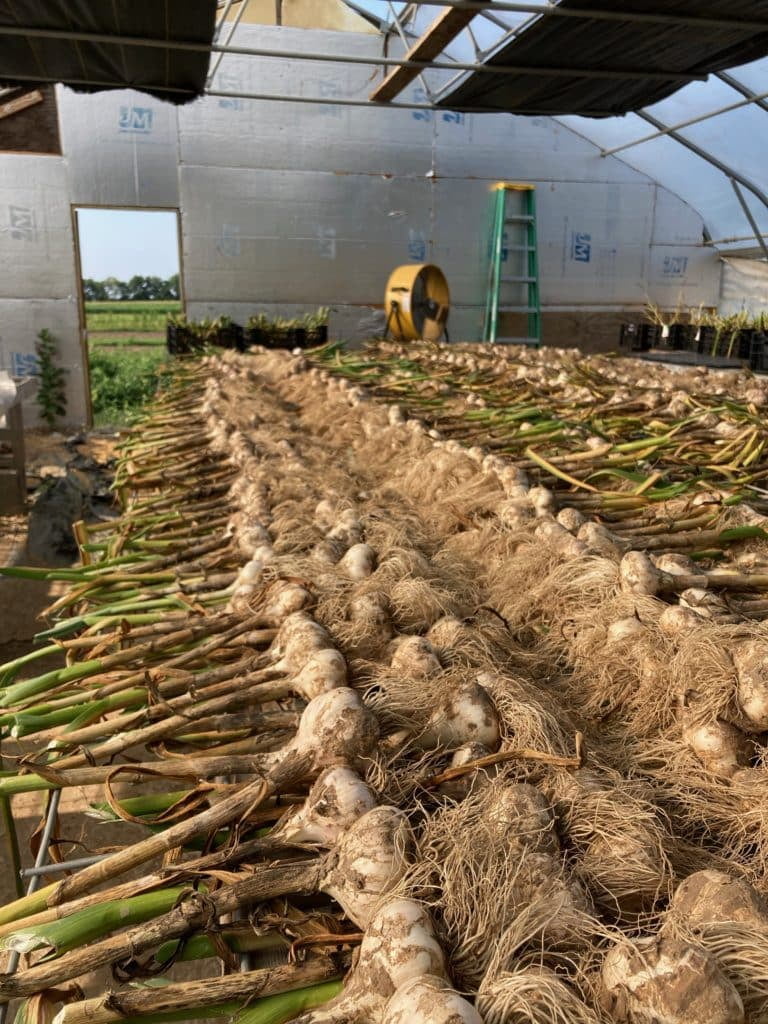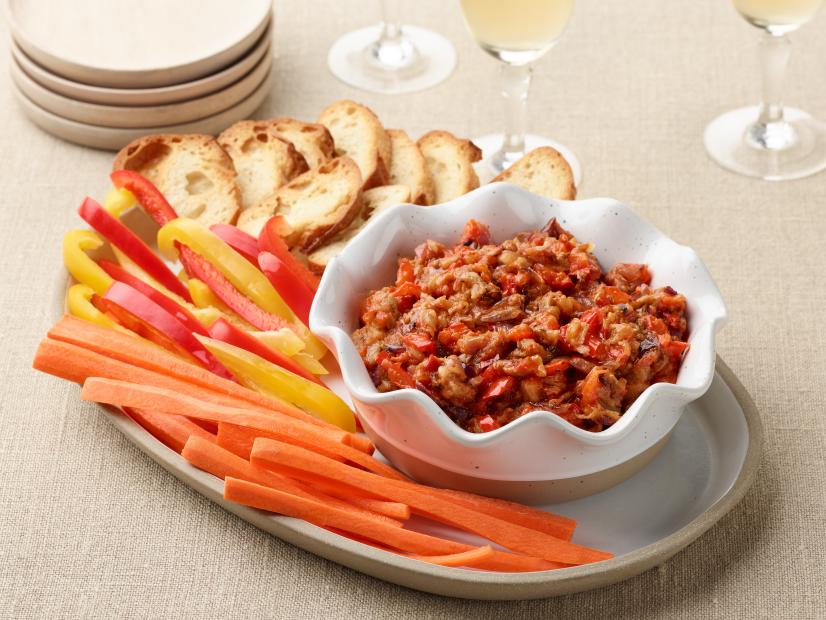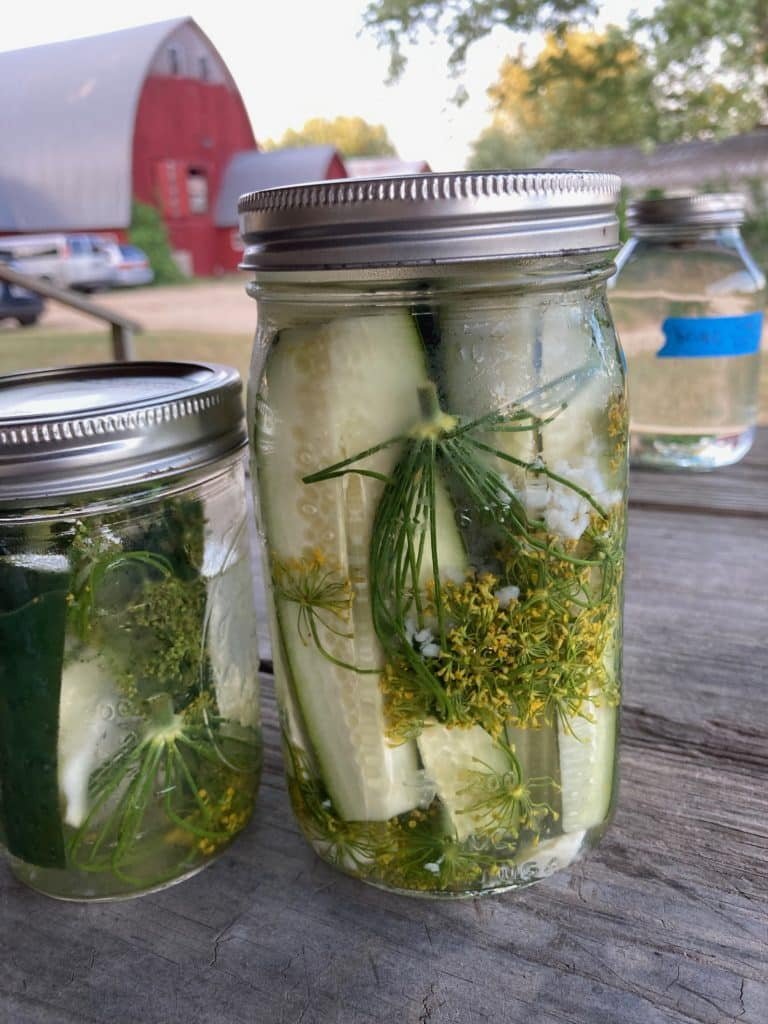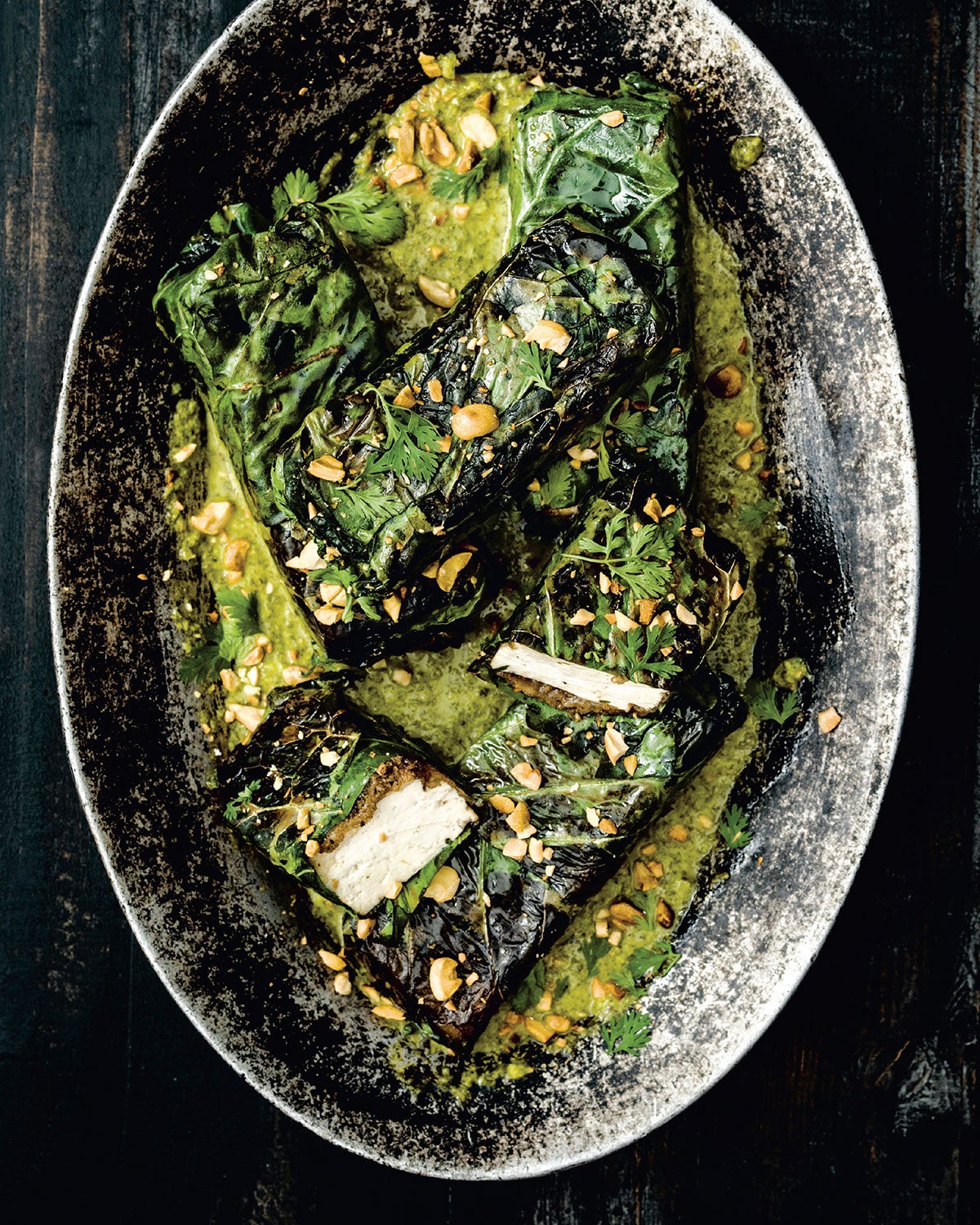Monthly Archives: July 2023
Week #11; Sweet corn begins.
- On: July 26, 2023
 0
0
Our garlic crop is harvested and safely drying. It was a sweaty, grimy harvest but very, very satisfying. It does not matter how many showers I take; I will smell of garlic for days. We were glad to get rain last night and doubly glad that the garlic was safe before it started.
Once the bulbs are dry enough, we’ll start packing them in the boxes.
Beth
Veggie List & Veggie Notes
Week #11
July 27/28, 2023 (Th/Fri sites)
– Weekly shares
– BiWeekly/ purple
– Sampler/ C group
Sweet corn, 7 ears
Muskmelon
Broccoli, ~2 lb
Cherry tomatoes, 1 pint
Slicing tomatoes, a few
Carrots, 2 lb
Globe eggplant, 1
Zucchini &/or yellow squash, ~2.5 lb
Cucumbers, 2 or 3
Walla Walla onion
Next week’s box will probably contain melons, tomatoes, carrots and more.
Sweet corn – Now it’s summer!
Advice about bugs. This is organic sweet corn. Many ears have caterpillars or bug damage at the tip. I suggest cutting off the tips before shucking the corn. Sweep the trimmed tips into the compost and you will never see the bugs. Going forward, not every harvest (nor every ear) will have the caterpillars. They come and go as the moths fly in from the south. I’ll give you an update here in the newsletter each week.
Storage. Sweet corn is best when fresh, so we encourage you to eat it asap. Store in the refrigerator, in the husks if you have the room, or husked and placed in a container or plastic bag.
Cooking. It is quicker to steam sweet corn than to boil it.
1.) Stand ears of corn upright in a tall pot. Put one inch of water in the pot.
2.) Bring the water to a boil. If the corn is cold when you begin cooking, steam for 5 – 6 minutes. If the corn starts at room temperature, steam for 4 – 5 minutes. The cooking time will vary somewhat depending on how many ears are in the pot. Pay attention to how the corn smells. The scent changes once the corn is ready. Another clue: water will bead on the corn until it is cooked. Don’t overcook it.
Muskmelon – Most are ripe and ready to eat. Some need to ripen a day or two on your kitchen counter. Refrigerate within 2 days.
Broccoli – Some of the broccoli is loose because of the warm weather but it all tastes great. Refrigerate.
Carrots – Refrigerate in the bag.
Tomatoes – Store your slicing tomatoes at room temperature. It’s only a few so you’ll eat them quickly. Cherry tomatoes can be refrigerated.
Eggplant – For best flavor, store eggplants at room temperature for 2 – 3 days. If holding for longer than three days, store in the warmest part of your refrigerator. Eggplants do not store well for long periods of time.
RECIPES by DEB
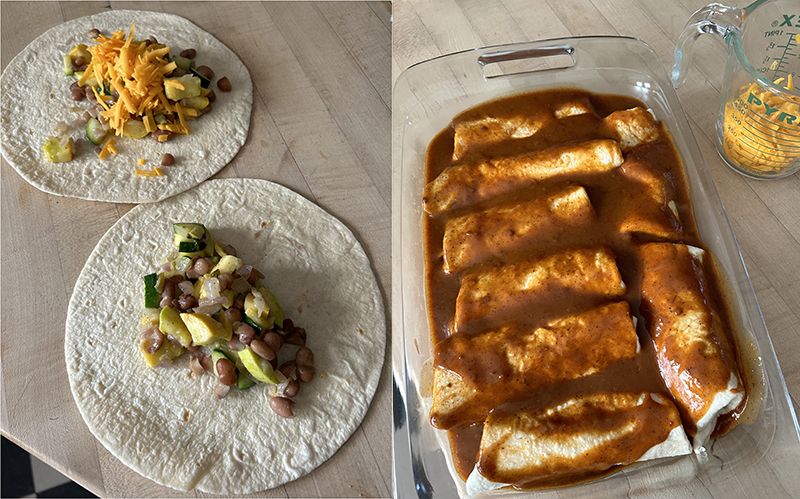
Photo by debslunch
Zucchini & Pinto Bean Enchiladas
This recipe for enchiladas and homemade enchilada sauce is very versatile! You can keep it strictly vegetarian or add meat, or do a vegan version using vegan cheese. Here I’ve used zucchini and pinto beans, but you could sub in corn or summer squash, and use purchased enchilada sauce if you don’t have time to make the sauce. Both the sauce and the enchiladas freeze really well, and if you want to add meat, I suggest 1/2 pound of ground beef, pork, turkey, or bulk chorizo. Brown the meat with the onions and then add any other vegetables you wish to use.
Serves 6-8
Takes about an hour and 15 minutes including baking
For the sauce:
2 tablespoons vegetable oil
1/4 cup flour
2 cups vegetable or chicken broth, preferably home made OR one 14.5 oz. can of broth plus enough water to make 2 cups (about 2-3 tablespoons)
1 1/2 tablespoons chili powder (You can control the heat of the sauce by using mild or hot chili powder. I often use part chili powder and part ground Ancho chile. Penzey’s is a good source.)
Optional, if you like heat: 1 chile from a can of chipotle chiles in Adobo sauce, finely chopped, plus a few spoons of the sauce
1-3 tablespoons of tomato paste
1 tablespoon brown sugar
salt and black pepper to taste
For the filling:
1 tablespoon vegetable or olive oil
3/4 to 1 pound of zucchini or summer squash or a mixture, cut into bite-size chunks
1 cup of pinto beans or corn
3/4 to 1 cup finely chopped onions
salt and black pepper to taste
For assembly:
8-10 flour tortillas
1/2 pound cheddar cheese, shredded
- Make the sauce: measure the oil and flour into a sauce pan and whisk to combine. Heat the broth in the microwave – a spouted glass measuring cup works well for this – and pour it into the pan while whisking until smooth and thickened. Add the chili powder, Adobo chile and sauce, tomato paste, and brown sugar and whisk until smooth. Simmer the sauce for about 10 minutes. Season with salt and pepper.
- Make the filling: Heat the oil over medium heat in a skillet. Add the onion and cook, stirring, until the onion is translucent. Add the zucchini and cook until it is just tender, about 5-10 minutes. Remove from the heat, season with salt and pepper, and stir in the beans (or corn if using).
- Assemble the enchiladas: Heat the oven to 375°. Microwave the tortillas briefly (45 seconds to a minute, depending on your microwave) to make them flexible. Pour a thin layer of sauce into the bottom of a 13 x 9 baking dish. Fill each tortilla with 1/3 cup of filling, top with about 2 tablespoons of grated cheese (reserving about 1/4 cup of cheese for topping), tuck the sides in, and roll neatly. Place the enchiladas in the baking dish as they’re rolled.
- Pour the rest of the sauce over the enchiladas. Place the baking dish in the oven and cook for about 20 minutes until bubbling. Top with the reserved grated cheese and return to the oven for about 5 minutes to melt the cheese. Serve the enchiladas with sour cream, chips, and salsa of your choice.
Roasted Eggplant Spread Recipe | Ina Garten
From Ina Garten, Barefoot Contessa Family Style
This quick and easy spread from Ina Garten, the doyenne of upscale comfort food, can be served as an appetizer or as the centerpiece of a light summer meal if accompanied by some protein. It also makes a tasty omelette filling. If you don’t have red bell peppers to roast along with the eggplant, you can use jarred roasted red peppers – just add them to the food processor with the other vegetables – no roasting required!
Since we have two pounds of broccoli this week, I’m including two cheesy main dishes that both feature broccoli.
Broccoli, Cheddar and Wild Rice Casserole | smitten kitchen
From smitten kitchen
With this recipe, Deb at smitten kitchen “saves” a traditional Midwestern hotdish, typically made with canned cream soup and frozen broccoli. Deb says as a child she envied friends who ate things like this regularly, since they were never served in her home, and when she decided to research and develop the recipe she was warned by other foodies it would be awful. Her recipe definitely meets the challenge!
.
.

Photo by Diana Chistruga
Easy One-Pan Broccoli Macaroni and Cheese
From The Spruce Eats
I chose this stove top mac & cheese since I think it has the best macaroni to broccoli ratio: 8 oz. noodles to 12 oz. broccoli. It calls for frozen broccoli, but you can use fresh by simply adding the chopped broccoli to the macaroni cooking water when the pasta has about 5 minutes to go rather than the one minute suggested for the frozen.
.
.
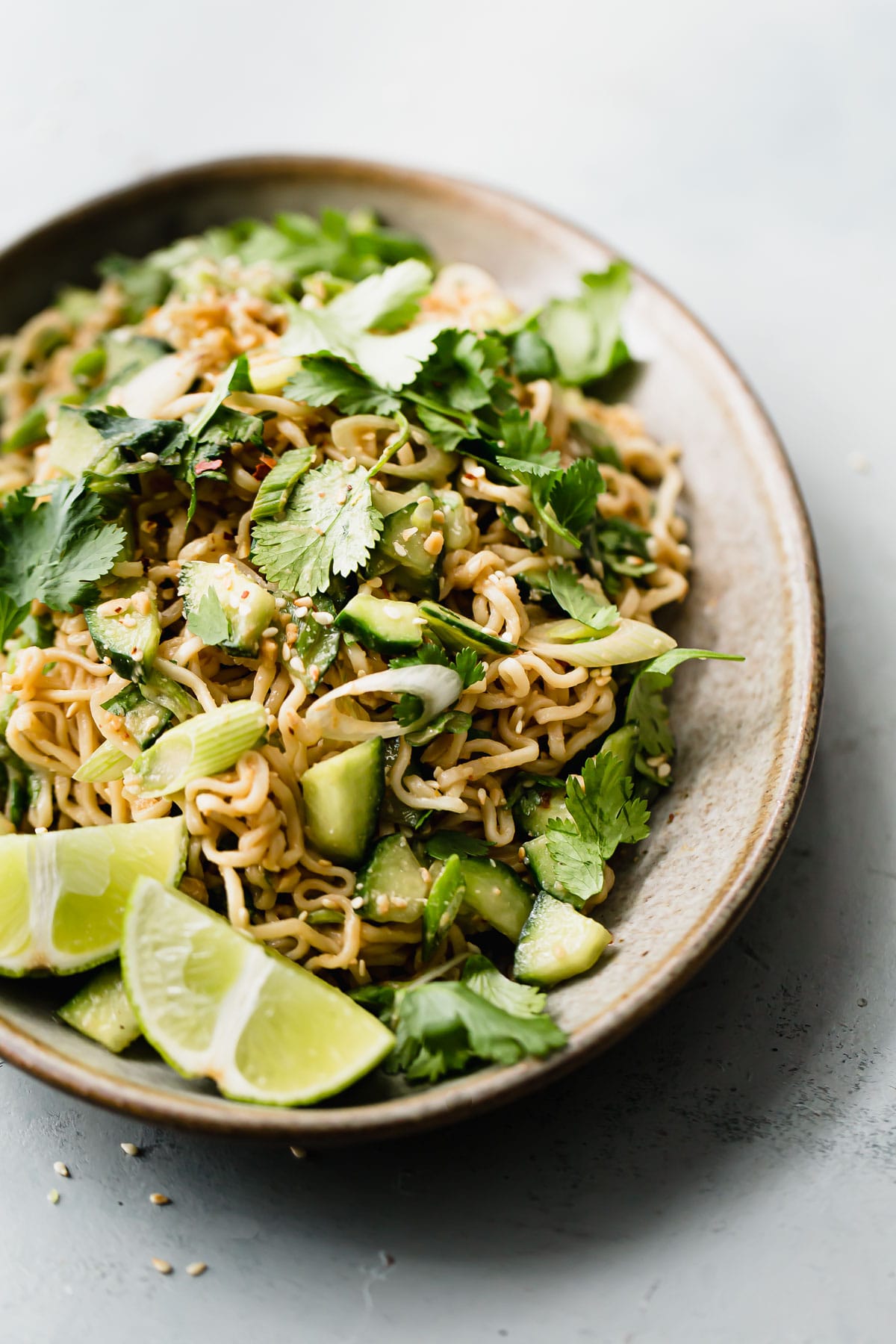
Photo by Laura Davidson
Spicy Peanut Noodles with Cucumber | A Beautiful Plate
From A Beautiful Plate
One inspiration for any one running out of cucumber ideas is to use the cucumbers in or as a topping for one of the spicy noodle salads that’re so good in the summer, or a stir fry. This recipe is an example of cucumbers in; looking back on some past Tipi recipes, you could try lightly marinated cucumbers in place of the asparagus on top of this tofu dish from Week 3, or this stir fry from October of 2021. To marinate the cucumbers, slice and place them in a bowl. Drizzle with a few tablespoons of rice vinegar, a pinch or two of salt, and optionally a little sugar. Leave them to marinate while you prepare the rest of the dish and then top individual servings with the cucumbers. I also found, but did not test, this recipe for cucumber noodles, where the cucumber is “zoodle-ized” to be the noodle. It strikes me that it would be tasty the first day and then potentially get kind of watery. If anyone tries it, how about posting to the Facebook group and let everyone know how it turned out! The recipe calls for seedless cucumbers – one way to adapt for seeded cucumbers is to cut your cucumbers into thin planks with a Y-shaped peeler then julienne the slices with a knife leaving out the seedy middles. And of course, if you have more zucchini than cucumbers, you could make this salad with actual zoodles.
.
.
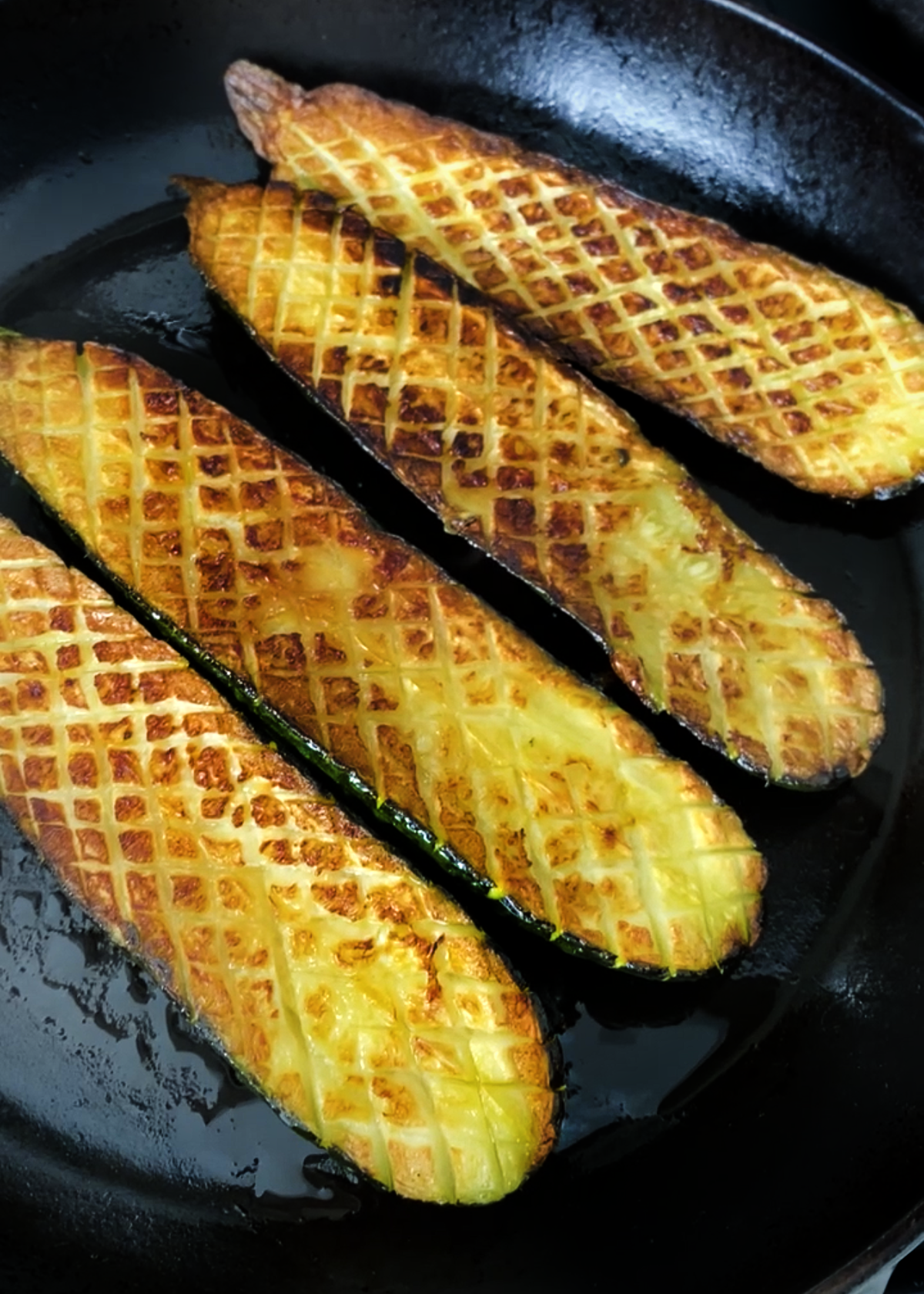
Roasted Zucchini, Thomas Keller’s Viral “Life-Changing” Method | The Delicious Life
From The Delicious Life
This recipe is all over the Internet this summer, and there are lots of videos illustrating how to prepare it if you like that kind of thing. Chef Thomas Keller’s method is to cut the zucchini in half, score it in a crosshatch pattern, and then salt and drain it, before pan frying it to brown the cut sides and finally roasting until tender. This free, non-video version of the recipe mentions the topping that’s in Keller’s original, a sauce vierge but doesn’t provide the recipe. Sauce vierge is simply chopped fresh tomatoes tossed with a little olive oil, vinegar or lemon juice, and whatever herbs you have. If you don’t eat all of our cherry tomatoes on the way home from box pickup, you could chop them up to top your zucchini!
.
.

Photo by Goydenko Liudmila / Getty Images
Flavored Butter Recipes | The Spruce Eats
From The Spruce Eats
Since this is the first time we’re getting corn, everyone’s most likely to eat it on the cob. Here’s a top ten list of flavored butters you might want to try to jazz up your corn. Numbers 1-5 are savory butters that pair well with corn, but I think some of the sweet ones would work too, like #7, Cranberry Butter.
Week #10; Let me help you with eggplant.
- On: July 19, 2023
 0
0
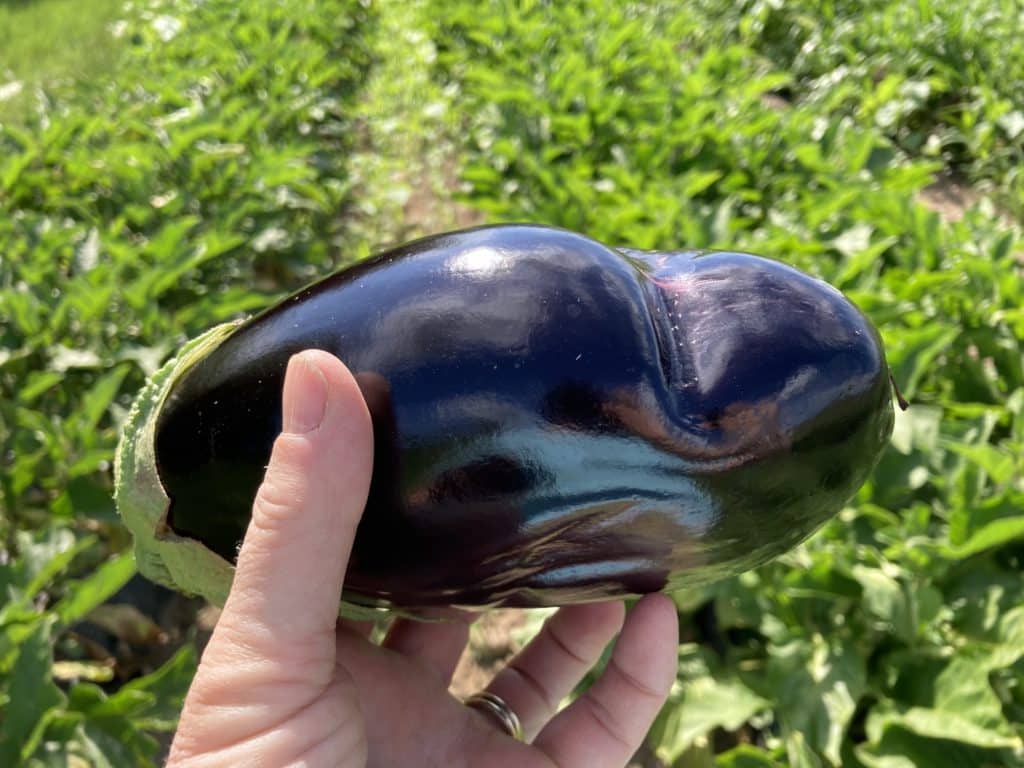
Don’t worry about funky eggplant shapes. They were shaped by growing quickly among the plant’s branches.
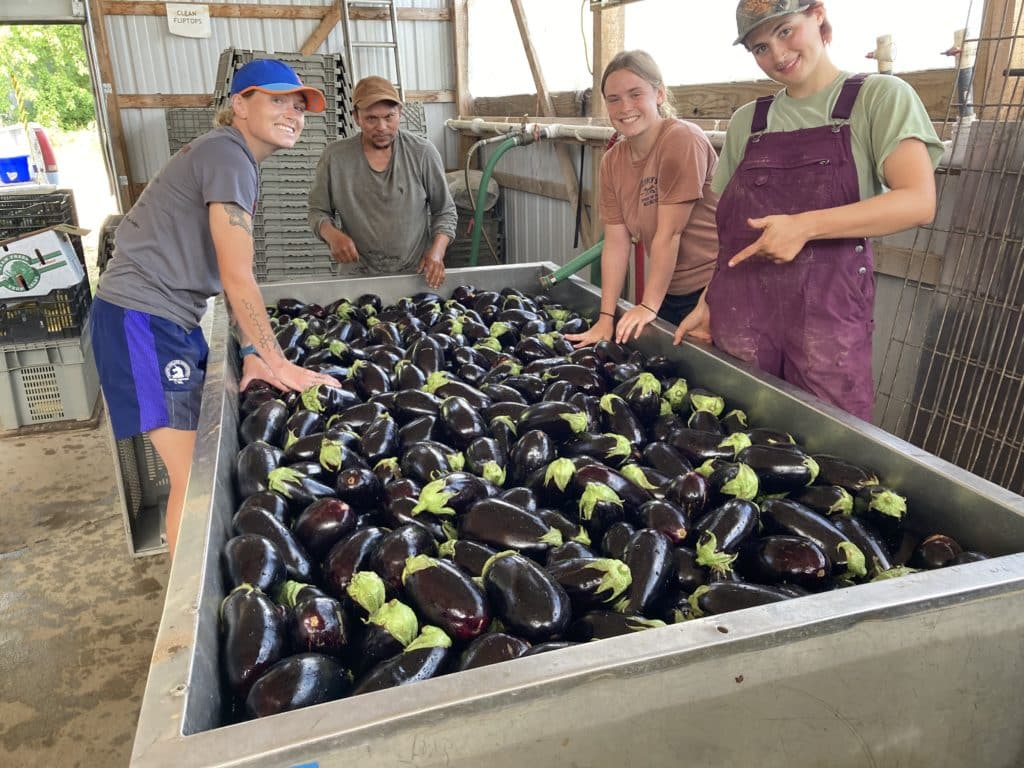
Team Eggplant brings in the harvest. The plants are very healthy, which makes a fun harvest. From left, Aly, Raul, Katie and Mary Ann.
If you are intimidated by eggplant, I can help
Storage
For best flavor, store eggplants at room temperature for 2 – 3 days. If holding for longer than three days, store in the warmest part of your refrigerator. Eggplants do not store well for long periods of time.
Hints for easy preparation.
Eggplant does not have to be time-consuming to prepare. Here are a few suggestions.
– Many recipes instruct you to salt and drain eggplant “to remove bitter flavors.” You do not need to salt this eggplant. We are sending you fresh eggplant and it will not be bitter.
– Try microwaving your eggplant, to speed preparation and reduce the amount of oil used. Microwaving is quick and eliminates the need to peel the eggplant; the skin ends up soft and edible. Unlike pan-frying, you need little oil when cooking in the microwave. The “Microwave Eggplant with Scallion-Chile Crisp Oil” recipe below uses this technique. The recipe is quick and absolutely delicious.
Eggplants are versatile. Here are other ideas:
– Roast in the oven or over coals to cook and smoke your eggplant, then transform into baba ganouj with lemon, tahini, salt and garlic.
– Cut in 1/2 to 3/4 inch slices, peel, and rub with a little salad dressing (I use Newman’s balsamic dressing), then grill slowly until soft and smoky. At this point, you can cut into cubes to make eggplant caponata with chopped tomatoes, onion, garlic, olives, capers, olive oil and red wine vinegar.
– Use the grilled cubes in casseroles or to top pizza.
– Add thin, grilled eggplant slices to grilled cheese sandwiches. Use hearty bread – this doesn’t work well with soft sandwich bread.
How to prep fresh garlic
Steve was baffled about how to prep last week’s fresh garlic. He muttered something about needing power tools, which I felt was overly dramatic. But perhaps some of you resorted to power tools last week, and I should show you the simple way to peel your fresh garlic. The only tricks are to peel (not cut) the outer layers, and to crush each clove to release it from its wrapper.
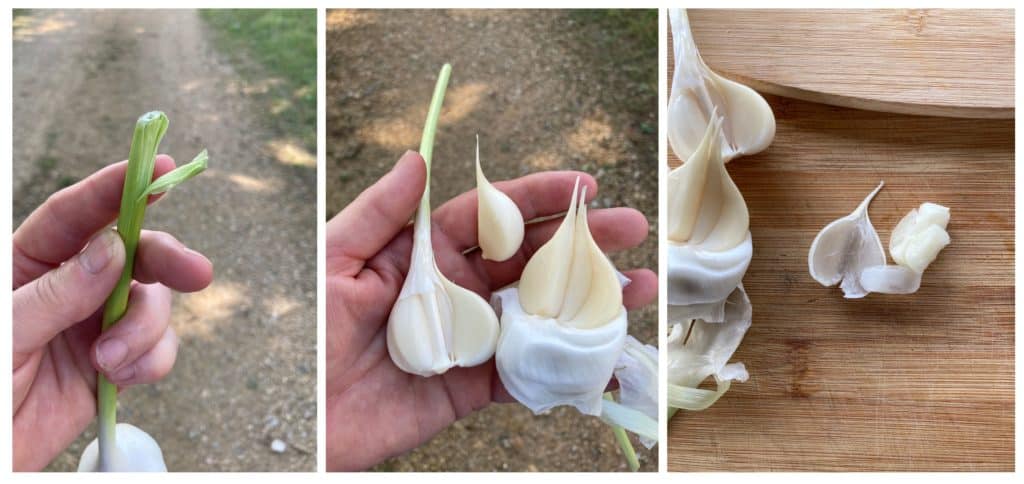
From left; Peel down the outer layers, one or two layers at a time. When the cloves are freed from the outer wrapper leaves, break them loose from the base. Crush each clove between two cutting boards to free it from its clove wrapper.
Veggie List & Veggie Notes
Week #10
July 20/21, 2023 (Th/Fri sites)
– Weekly shares
– BiWeekly/ green
– Sampler/ B group
Green cabbage
Broccoli, about 2 medium heads
Globe eggplant, 1
Green leaf lettuce
Green bell pepper, 1
Zucchini &/or yellow squash, ~2.5 lb
Cucumbers, 3
Walla Walla onion
Basil, 1 stalk
Fresh garlic
By site: Muskmelon OR cherry tomatoes. I will distribute melons and cherry tomatoes to each pickup site over the coming weeks, to be sure we reach all sites. Please don’t open boxes at your site looking for variety – all boxes at each site are identical.
Next week’s box will probably contain sweet corn, melon, broccoli, zucchini and more.
Broccoli – Our second planting has done very nicely, much better than usual, considering the weather.
Storage: Refrigerate.
Cabbage – You will receive either Caraflex (pointy) or Farao (round). Both are intended as salad/slaw cabbages but can be lightly cooked too.
Storage: Refrigerate.
Muskmelons (some sites) – These are ripe and ready to eat. Refrigerate.
RECIPES by BETH
Deb is busy with family so I am on recipe duty. Let’s share a few of our favorite dishes and strategies.
Make a pot of rice
It’s not a joke! It’s a cooking strategy. We’re busy, you’re busy. For us, strategy #1 is to cook a big pot of brown rice once per week. Sometimes I’ll come down in the morning and find Steve cooking rice at 6:00am, while he’s still in the house for an hour. Then we prep dishes to accompany the rice through the next days.
.
.
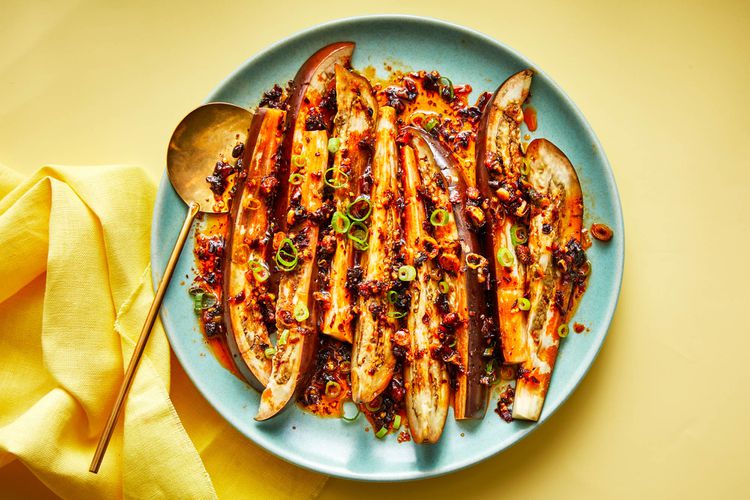
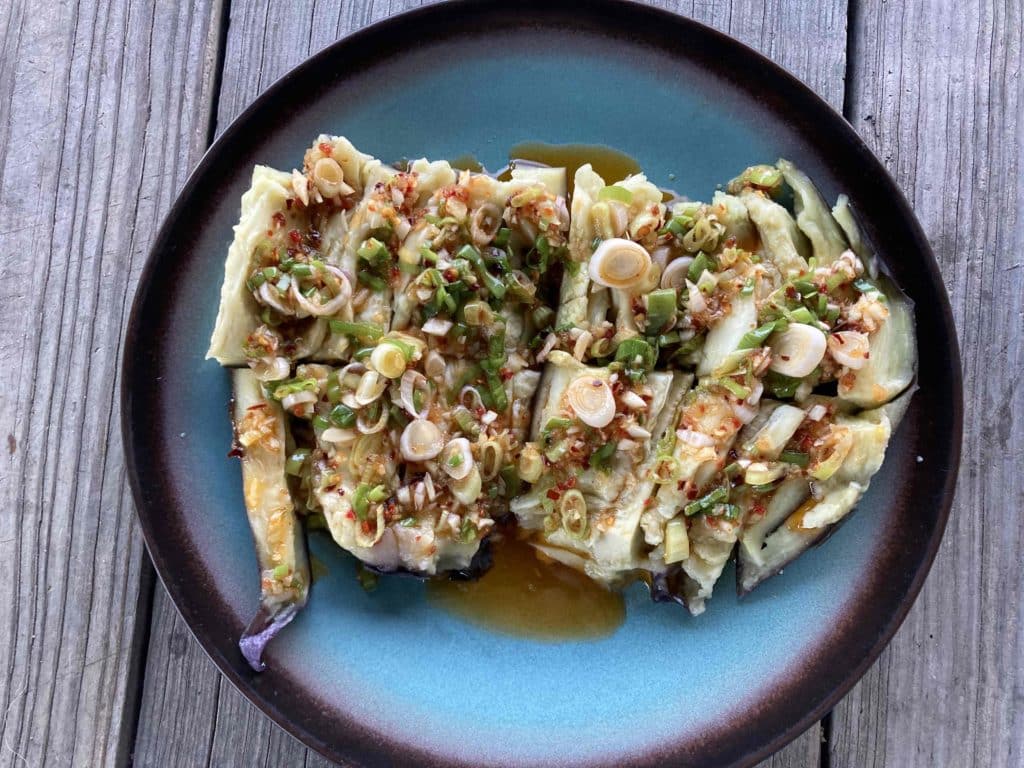
Top: From Food & Wine, Photo by Antonis Achilleos, Prop styling by Christina Daley, Food styling by Ali Ramee.
Bottom: My cooked dish. It was delicious.
Microwave Eggplant with Scallion-Chile Crisp Oil
By Andrea Nguyen, in Food & Wine:
“This microwave eggplant recipe from Andrea Nguyen requires none of the usual fuss of salting and straining the nightshade beforehand. Cooking a whole eggplant in the microwave effortlessly, evenly, and quickly cooks its flesh to soft, silky tenderness while preserving its antioxidant-rich skin. Cut into thick slices and drizzled with generous spoonfuls of flavorful sauce, microwave eggplant is an easy and delicious side dish that comes together in 20 minutes flat.”
Here is a great, flavorful recipe that uses your microwave for eggplant prep. I’ll bet that some of you still have a few scallions in your fridge. Otherwise, sliced Walla Walla should make a good substitute. I followed the cooking times in the recipe for my 1 lb eggplant, adding the suggested extra 60 seconds, and the eggplant was beautiful: plush, with edible skin. Give the recipe a try – I think you’ll like it.
.
.
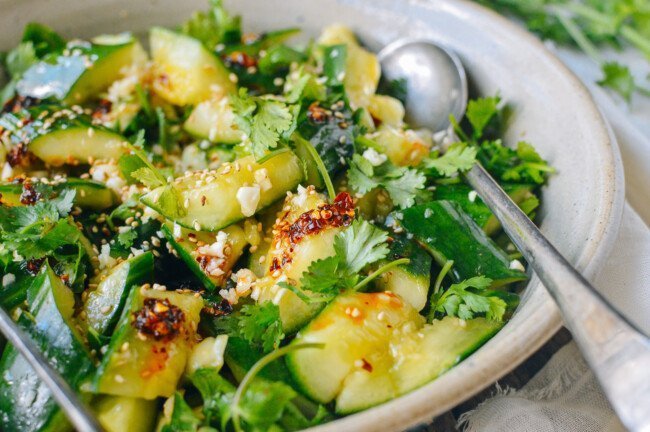
Photo by The Woks of Life
Smashed Asian Cucumber Salad
From The Woks of Life
We rotate among a variety of cucumber salads while they are in season. This smashed salad is Ari’s favorite. The rough surfaces hold the dressing well. We use a recipe from the New York Times (Chinese Smashed Cucumbers With Sesame Oil and Garlic) but that recipe is behind a paywall and this one from Woks of Life is virtually identical. We skip the cilantro and use Korean pepper flakes instead of chili oil.
Cucumber salad is surprisingly good with rice, especially if you add cooked salmon or tofu. It’s reminiscent of nori rolls. You can always sprinkle toasted nori sheets on top.
.
.
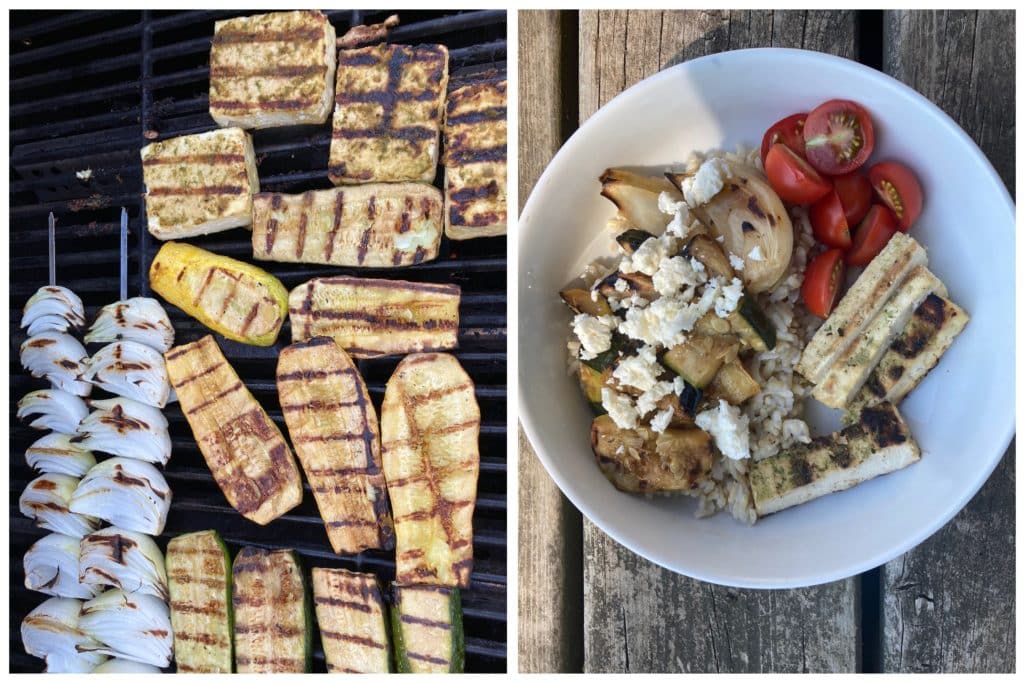
Grilled vegetables
I often grill a batch of marinated vegetables and tofu at the beginning of the week, without a clear plan how we’ll use them. They always get eaten, whether with rice or pasta, or as a side dish. In this week’s box, zucchini, Walla Walla onions and eggplant are all suitable for grilling.
Zucchini or Zephyr squash – Slice about 1/3 inch thick. Douse in a simple marinade. We use a mix of rice vinegar, sesame oil and soy sauce. Bottled salad dressing works great too. If your marinade does not have oil, spray or brush lightly with oil. Grill over low heat until tender, turning once. Slice into ribbons and mix with the marinade again.
Walla Walla onion – Slice into chunks and thread onto skewers. Grill over low heat until tender and nicely charred. Flip at least once.
Eggplant – Cut in 1/2 to 3/4 inch slices, peel, and rub with a little salad dressing (I use Newman’s balsamic dressing), then grill slowly until soft and smoky.
.
.
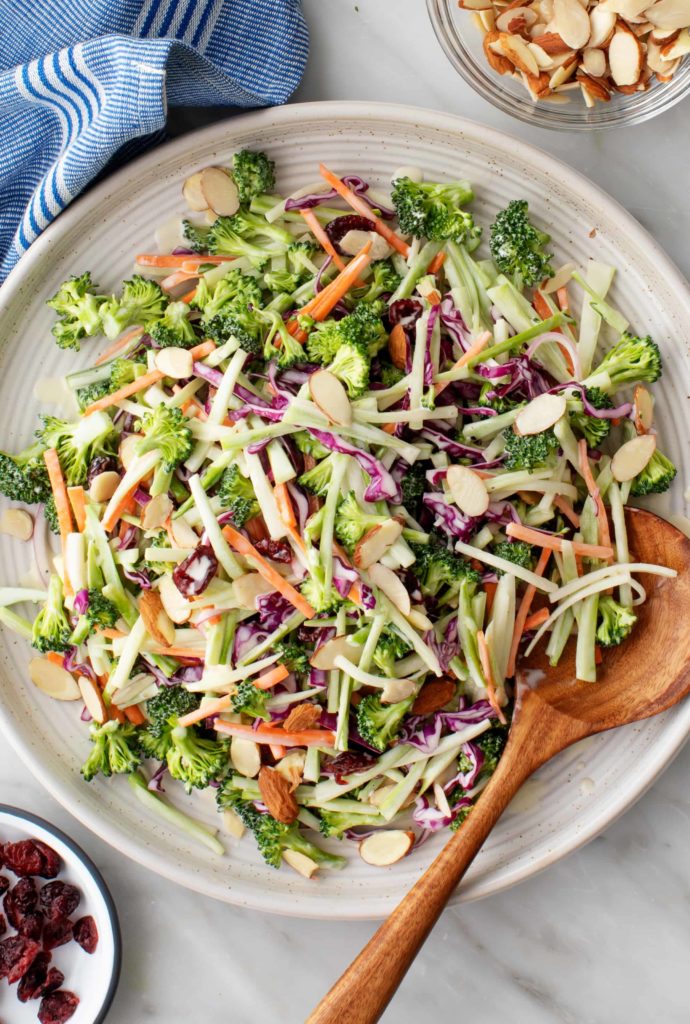
Photo by Love & Lemons
Broccoli Slaw
From Love & Lemons
The dressing for this mixed broccoli and cabbage slaw is traditional but nicely balanced, with mayo, cider vinegar, dijon mustard, and maple syrup.
Week #9; A bit of rain; Purple + A
- On: July 12, 2023
 0
0


Irrigation by day, irrigation by night.
We got 0.9 inch of rain today. That is the largest rain since mid-May. After nine long weeks, the farm is very dry and that 0.9 inch will disappear quickly. We won’t irrigate tonight and will watch the weather forecast for the next few days. Perhaps we will get some more.
Refrigerator Pickles
Let’s talk quick pickles, since we are sending four cucumbers this week. Here is the recipe that I use. (Deb gave us a different refrigerator pickle recipe two weeks ago, plus new ideas below.) I usually prepare and store extra brine so I am ready to pickle another batch or other vegetables. I make simple pickles (cucumbers, dill, garlic) but you can dress them up with other aromatics.
Brine (enough for 2.5 to 3 packed quart jars)
4 cups water
1 cup vinegar
3 Tbsp pickling salt
Combine and stir to dissolve.
Pickles, 1 quart
Washed cucumbers, cut into spears
1 small or 1/2 large dill umbel
1 garlic clove, crushed
Pack a clean one-quart jar with the cucumber spears, garlic and dill. Fill with brine to the top, seal with a lid and put in the fridge. Ready to eat the next day and really good on the second day.
After eating your pickles, you can re-use the brine by adding fresh cucumber spears. You will not need to add more garlic or dill. After the second batch, I throw away the brine.
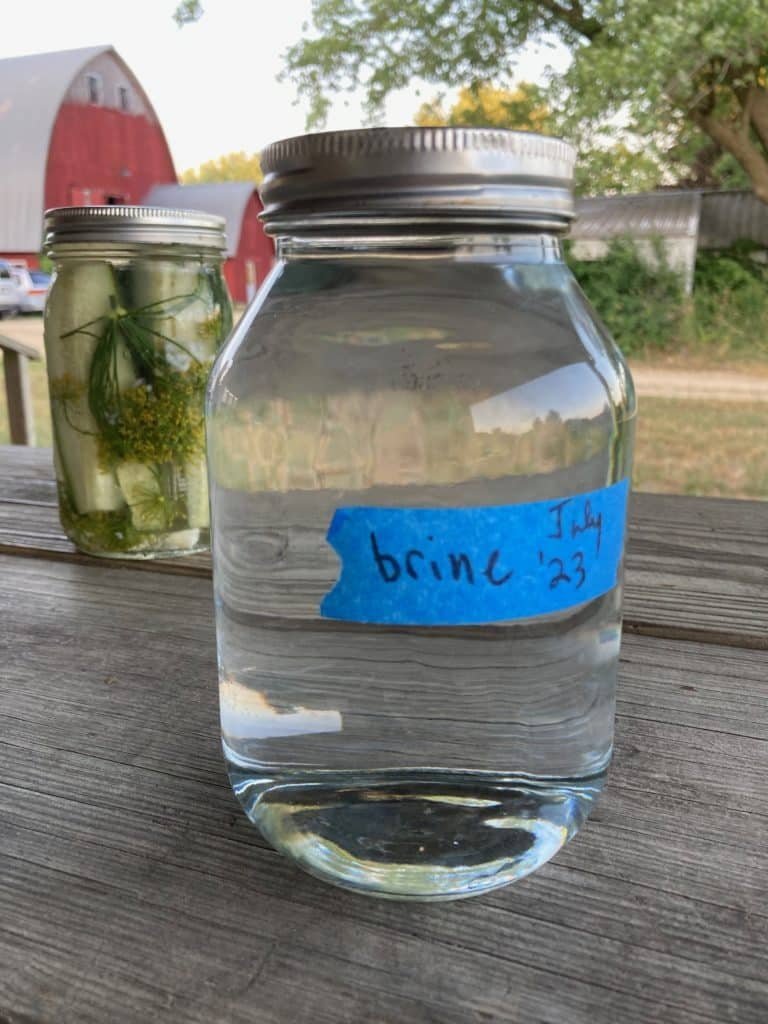
Extra brine ready for the next batch of pickled cucumbers, red peppers, etc.
Veggie List & Veggie Notes
Week #9
July 13/14, 2023 (Th/Fri sites)
– Weekly shares
– BiWeekly/ purple
– Sampler/ A group
Beets, ~2 lb
Broccoli, 1 – 2 medium heads
Collards, 1 bunch
Green bell pepper
Walla Walla onion
Zucchini &/or yellow squash
Cucumbers, 4
Fresh garlic, 1 bulb
Basil, 1 bunch
Dill, 1 umbel
Next week’s box will probably contain cabbage, Walla Walla onion, zucchini, cucumbers, fresh garlic and more.
Beets – Storage: Cover and refrigerate. Beet roots store quite well when refrigerated. Wash well to remove leaf fragments. For all the cooking methods below, wash and scrub the beets but do not peel. The skins slip off readily once the beets are cooked and cooled.
Cooking beet roots on the stovetop: Slice or quarter, cover with water in a pot, and simmer until tender. This will take from 25 to 45 minutes depending on how large the beet pieces are. Drain.
Roasting beets in oven: Wash beets, but do not peel. On a sheet of aluminum foil, put beets (halved or quartered if large), salt, pepper and a few sprinklings of water. Seal the foil packet, and roast at 400 oF until tender, about 45 minutes to 1 hour. Slip off skins once cool.
Microwave: Slice beets in half and place in a large microwave-proof bowl. Add ¾ inch water and cover with a plate. Microwave on high until tender, about 9-20 minutes, depending on your microwave’s power. Drain and slip off skins.
Uses: Use cooked beets in cold salads, or dress simply with vinaigrette, onions, salt and pepper. Beets are also good tossed with sour cream, minced onion, fresh herbs and walnuts.
Broccoli – Storage: cover and refrigerate. Broccoli is sensitive to warm temperatures so do your best to keep it cold. If your broccoli seems wilted, soak in cold water for fifteen minutes and it will plump back up.
Collards – Collards grow nicely and keep their quality in summer, when other greens are not at their best. Handle collards like kale. They are interchangeable in recipes.
Storage: Refrigerate.
Green bell pepper – Refrigerate.
Walla Walla onion – This batch of Walla Walla onions is a bit different. As usual, the are sweet and crisp but more pungent than we usually see. They remain less pungent that yellow storage onions. Wallas are sonderful raw or lightly cooked. Try cutting into wedges, threading on a skewer and grilling. Do not try to fry these onions – it doesn’t work because of their high water content.
U: It’s OK to store at room temperature for up to one week. Otherwise, refrigerate.
Fresh garlic – These plump bulbs are the Korean Red variety. Fresh garlic is special; crunchy, juicy and incredibly pungent. We pull these bulbs a week or so before we begin the big garlic harvest. The outer papers on the bulb and individual cloves are still succulent, not dried. After you separate a clove from the bulb, try lightly crushing the clove between two cutting boards to release it from its wrapper.
Storage: I suggest that you refrigerate this bulb of garlic, so it remains easy to peel. The garlic is fine if you leave it at room temperature but the cloves will become difficult to peel as the bulb dries.
Basil – Store at room temperature, in a glass of water. This week’s harvest is bunched, smaller stems. See last week’s newsletter for detailed storage instructions.
Dill – I am sending one umbel so you can make refrigerator pickles. What you receive could be either a flower head or young seeds. Either is great for pickles. These are large umbels, big enough for two jars. Slice in half down the stem with a paring knife.
Storage: Trim the stem ends and store in a glass of water at room temperature. I encourage you to store your dill and basil in separate glasses.
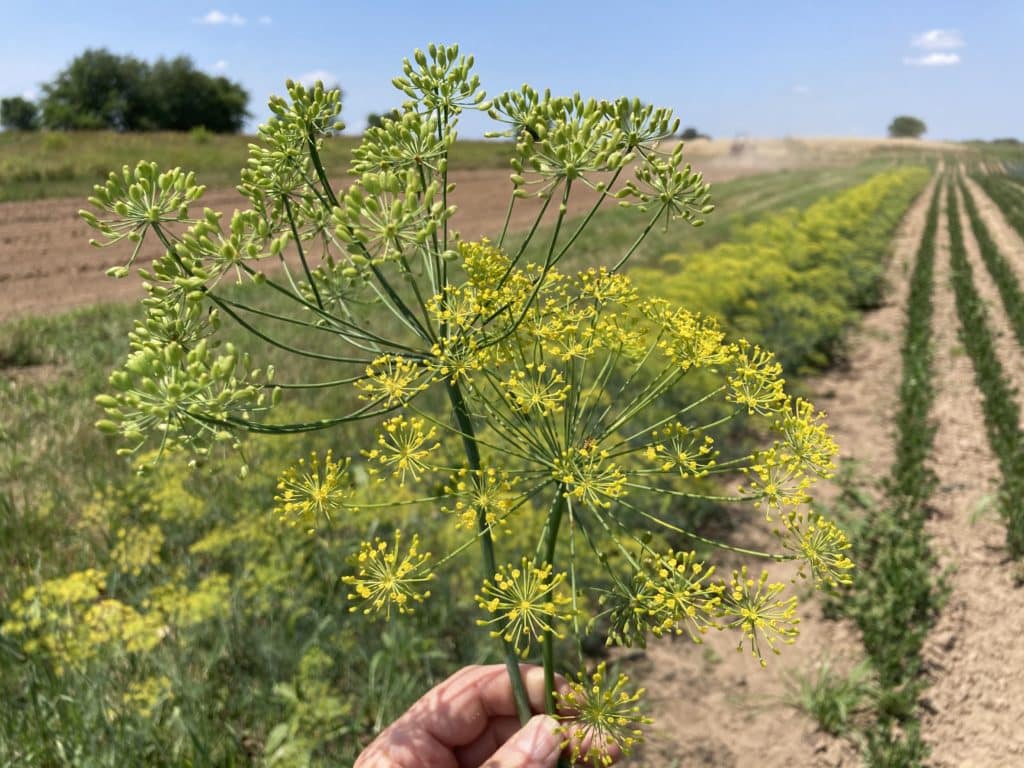 Everyone gets one dill umbel. Could be a head of young seeds (left) or flowers (right).
Everyone gets one dill umbel. Could be a head of young seeds (left) or flowers (right).
RECIPES by DEB
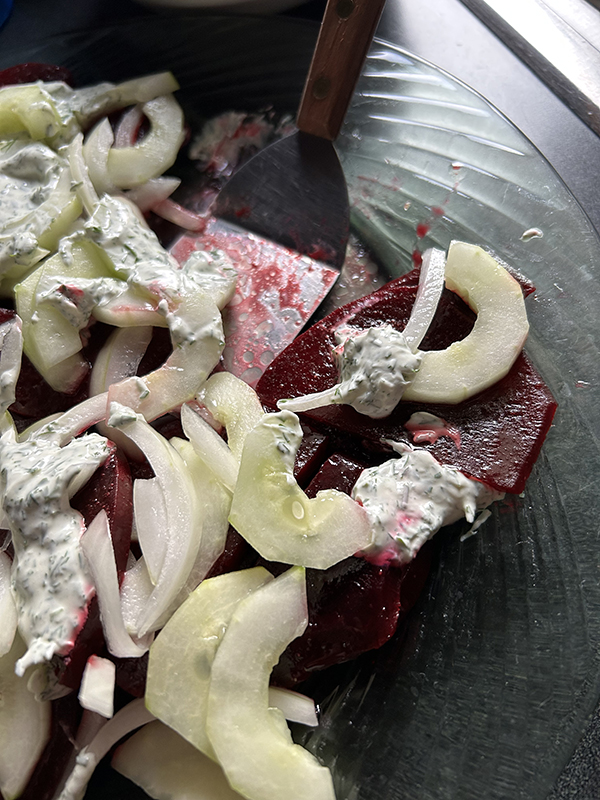
Beet and Cucumber Salad
Photo by debslunch
With a hat tip to Julia Turshen, here’s a summer-y salad with cooked beets and lightly pickled cucumbers. I used fresh dill since that’s what I had, but the basil in this week’s box would also be tasty. The dressing can be made with plain yogurt – whole milk or Greek style works best, or sour cream, or crème fraîche, the last of which can be purchased, but you can make it yourself by whisking equal amounts of heavy cream and sour cream together. This works best with cream that is not ultra-pasteurized – a local brand is Sassy Cow. Leave to sit at room temperature overnight or until thickened then refrigerate where it will keep for 4-5 days.
Serves 4-6.
Takes about 30 mins. active time, plus 40 minutes or so to cook the beets
1 pound beets
1 large cucumber
1/2 cup Walla Walla onion slices
1 teaspoon sugar
2 tablespoons white wine, cider, or rice vinegar
pinch of kosher salt
2 tablespoons olive oil
salt and freshly ground black pepper to taste
1/3 cup plain Greek or whole milk yogurt, sour cream, or crème fraîche
2 tablespoons finely chopped fresh herbs, such as basil, dill, or parsley
- Preheat the oven to 350° if roasting the beets. Trim and scrub the beets. If roasting, place them in a baking dish that holds them fairly snugly – preferably glass; it’s easier to clean! – and cover tightly with foil. Place in the oven and roast until fork tender. Cooking time will vary based on the age and size of the beets, so start checking after 30 mins. If you want to cook the beets on the stove, place the cleaned beets in a large pot, and add cold water to cover. Remove the beets, and bring the pot of water to a boil on the stove. When it’s boiling add salt and the beets, and adjust the heat to keep them a quiet simmer. Same as roasting, start checking for tenderness after about 30 mins.
- Peel the cucumber if you like, and seed it by cutting it in half lengthwise and scooping out the seeds with a spoon. Slice fairly thinly. Place the cucumber slices and the onion slices in a bowl, and add the sugar and pinch of kosher salt. Pour the vinegar over, toss, and set aside to marinate.
- When the beets are tender, remove from the oven and drain and cool just until they can be handled. Skin the beets – some people do this by rubbing the skins off with paper towel. I like to do it under cool running water, which also reduces the cooling time. If the skin sticks in spots just peel that off with a small knife. Slice the beets, place in a mixing bowl, and toss with the olive oil and salt and pepper to taste.
- Arrange the beets on a serving platter or individual plates. Remove the cucumbers and onions from the vinegar with a slotted spoon or your hands and place on top of the beets. Blob the dressing on top and serve right away. The salad still tastes good the next day but all the components will be dyed beet color.
Bryant Terry’s Jerk Tofu Wrapped in Collard Leaves | Penguin Random House Canada
From Penguin Random House Canada
This recipe was created by chef and activist Bryant Terry, and is the cover image of Terry’s 2020 book, Vegetable Kingdom. Bryant Terry specializes in vegan versions of Black American foods. You’ll find other online versions of the recipe, such as at Epicurious, but might run into a pay wall there. The recipe produces an impressive, knife & fork vegan entree and there’re a lot of steps to make all the components, but you can marinate the tofu in bottled barbecue sauce in place of making the jerk marinade, and I have omitted the cilantro sauce and it’s still tasty. I believe Chef Terry uses arrowroot instead of cornstarch because cornstarch is a product of industrial agriculture, but I have also subbed more readily available cornstarch for the arrowroot with success.
.
.
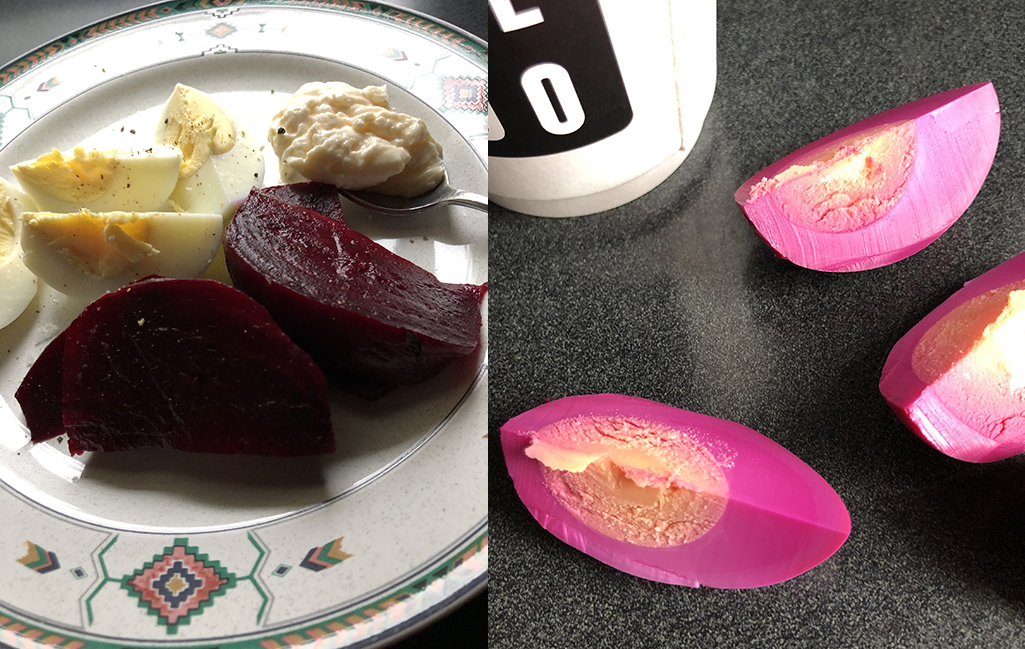
Photo by debslunch
I think my favorite way to eat beets is pickled, preferably with eggs and a dab of mayo. This isn’t really a recipe; more of a formula. I like to roast the beets (see instructions in the salad above) but you can also boil the beets if you don’t want to turn on your oven on a hot day. In the picture, the eggs on the right were in the beet juice for about 5 days.
Pickled Beets & Eggs
1 pound of beets
1 1/2 cups cider vinegar
1/2 cup or more water
1/3 cup sugar
2 teaspoons salt or more to taste
About a teaspoon whole spices such as allspice, cloves, or 1-inch piece of cinnamon stick; some people like a clove or two or garlic as well
4 warm hard-boiled eggs
Boil or roast your beets, peel them, slice them, and place in a container or bowl with a lid that’s large enough to hold the brine and the eggs. Add the whole spices. Combine the vinegar, water, sugar, and salt in a pot or glass measuring pitcher, then either heat on the stove or microwave the glass pitcher long enough to melt the sugar. Pour over the beets. Hard boil the eggs – there are a zillion methods but this is mine: place cold eggs in a pot and add cold water to cover. Place over high heat and bring to a boil, and soon as the sides of the pot have a few bubbles, set a timer for 13 minutes. Lower the heat as necessary to keep the eggs at a nice boil, but not boiling over. When the timer goes off, remove the eggs from the heat and flood the pot with cold water in the sink. Peel the eggs and add to the beets and brine, adding more hot water or vinegar if needed to cover. Place the container in the fridge and allow to pickle at least overnight before serving.
.
.
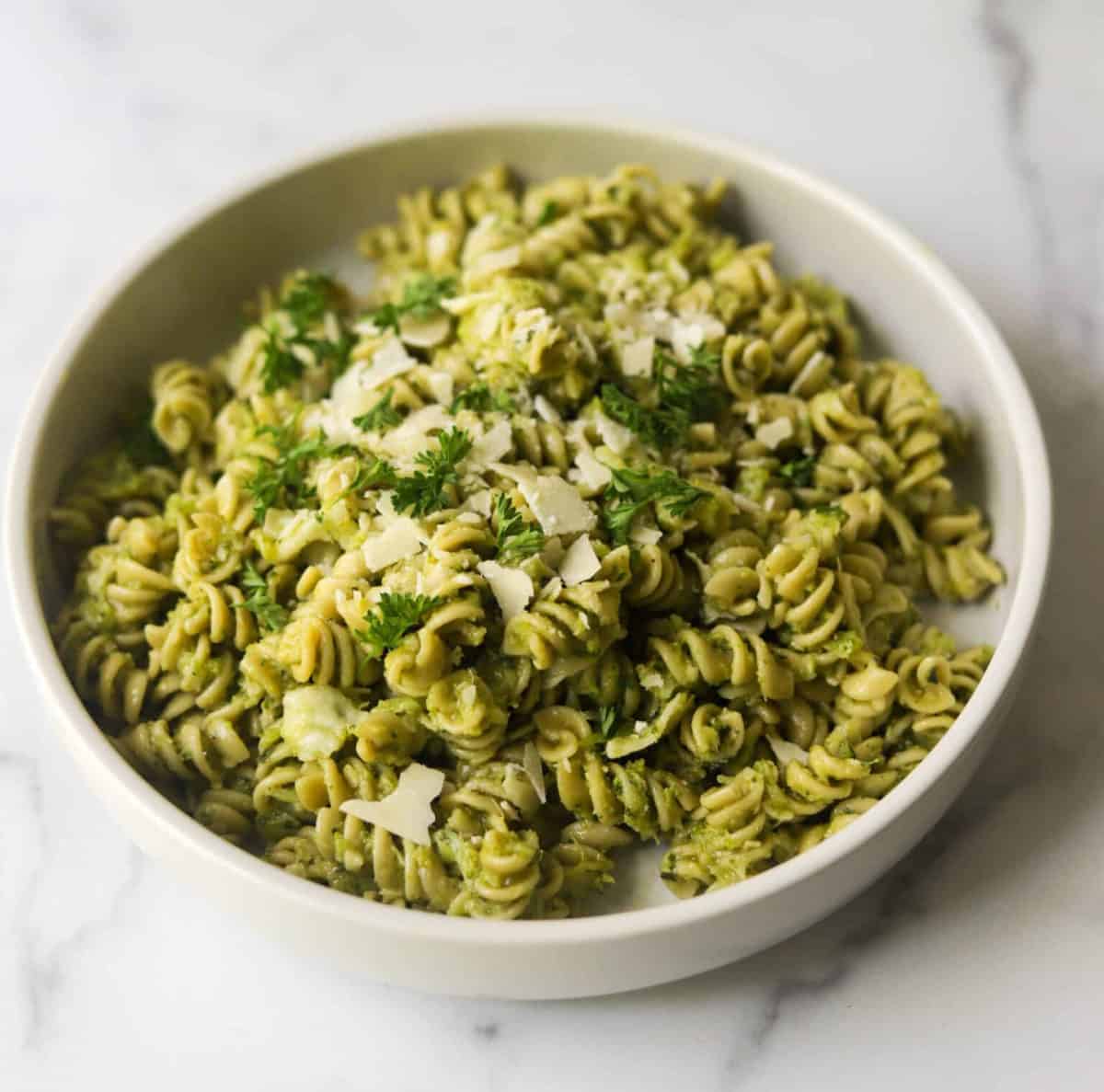
Broccoli Pesto Pasta Salad | The Healthy Epicurean
From The Healthy Epicurean
This pasta pesto salad includes both broccoli and basil in the pesto. The recipe provides a number of substitutions, and if you don’t have quite enough broccoli, slip in a few blanched kale or collard leaves and increase the basil.
.
.
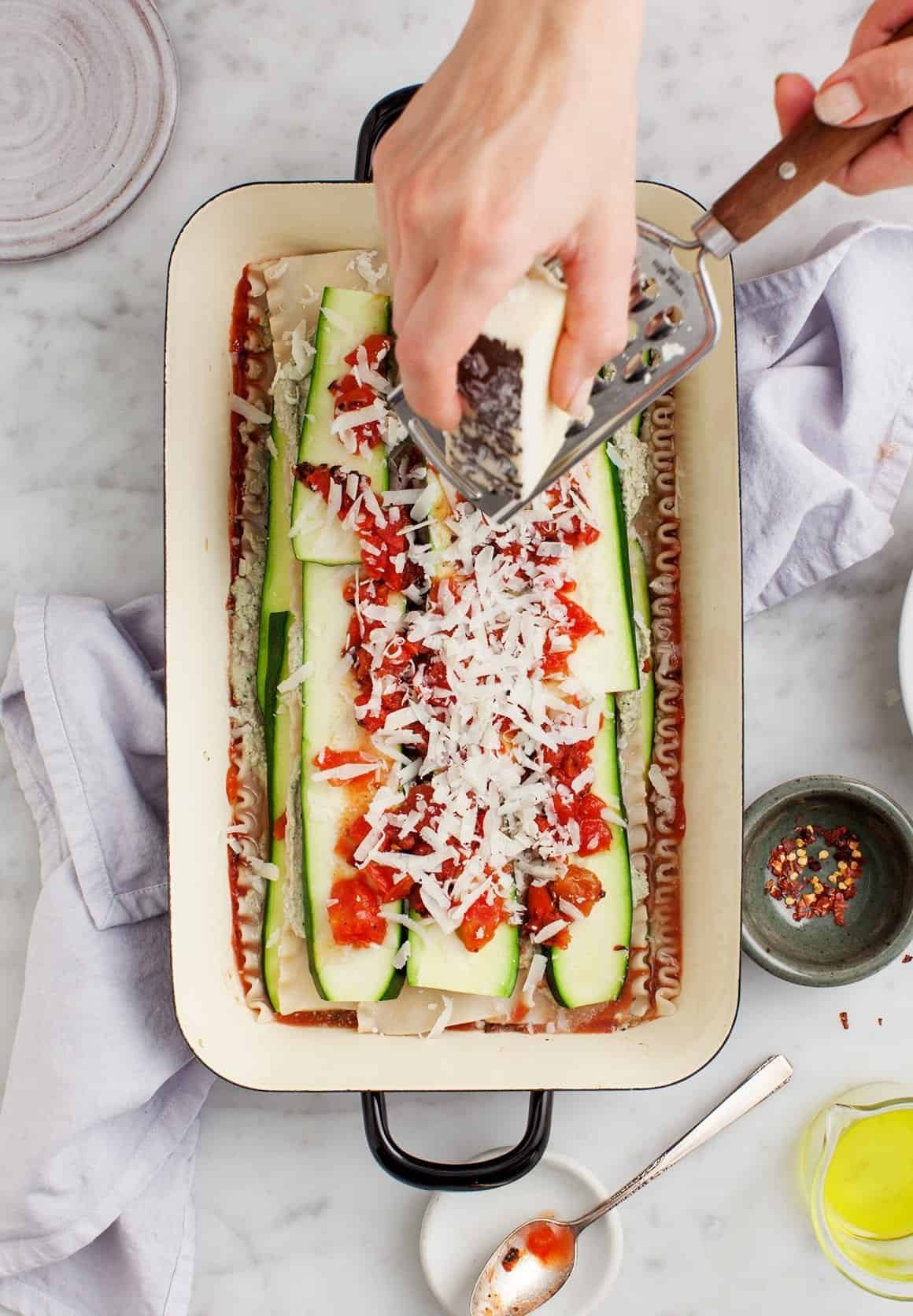
Zucchini Lasagna Recipe | Love and Lemons
From Love and Lemons
This recipe uses zucchini two ways: in the tofu filling and as planks replacing some of the noodle. You could sub about 8 ounces ricotta cheese and an egg for the tofu and walnuts in the filling, and the dish would still be lower carb and lower fat then a typical lasagna.
.
.
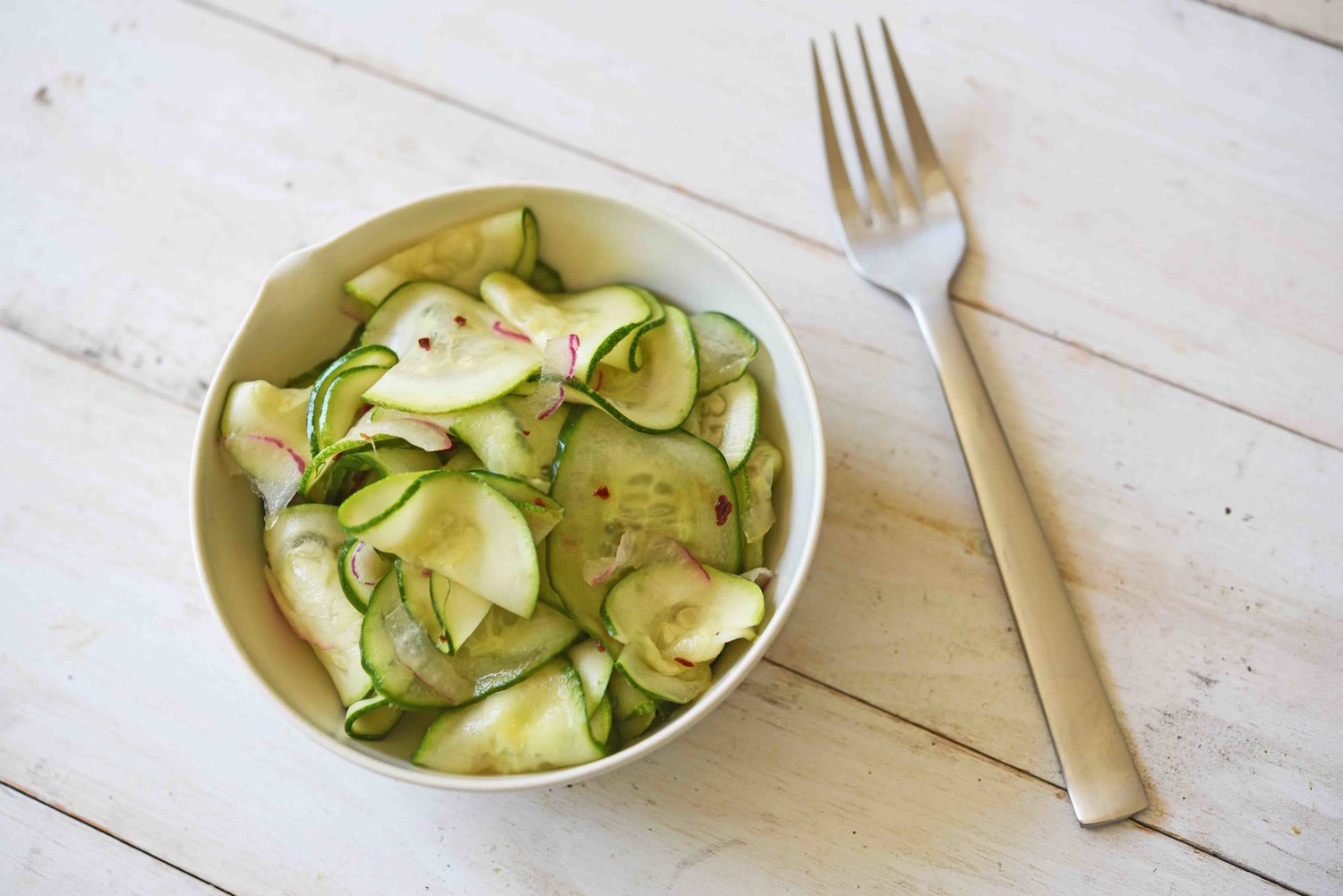
Cucumber Zucchini Salad — Nikki Dinki Cooking
From Nikki Dinki Cooking
It looks like the author of this blog has moved their newer content over to Instagram, but regardless, this recipe provides a great idea for using cucumbers and zucchini for this time of the summer when we have a lot of both – treat them the same and make a refreshing marinated salad. Of course you could make this salad with all cucumber or all zucchini! The Walla Walla onion in the box can be subbed in place of red onion. Beth says the Walla Wallas are unusually strong, and if they seem so to you, I recommend soaking the slices in cold water for a few minutes and draining before proceeding with the recipe. And for another way to use our cucumber bounty, see this July 2021 newsletter for small batch refrigerator pickle relish.
.
.
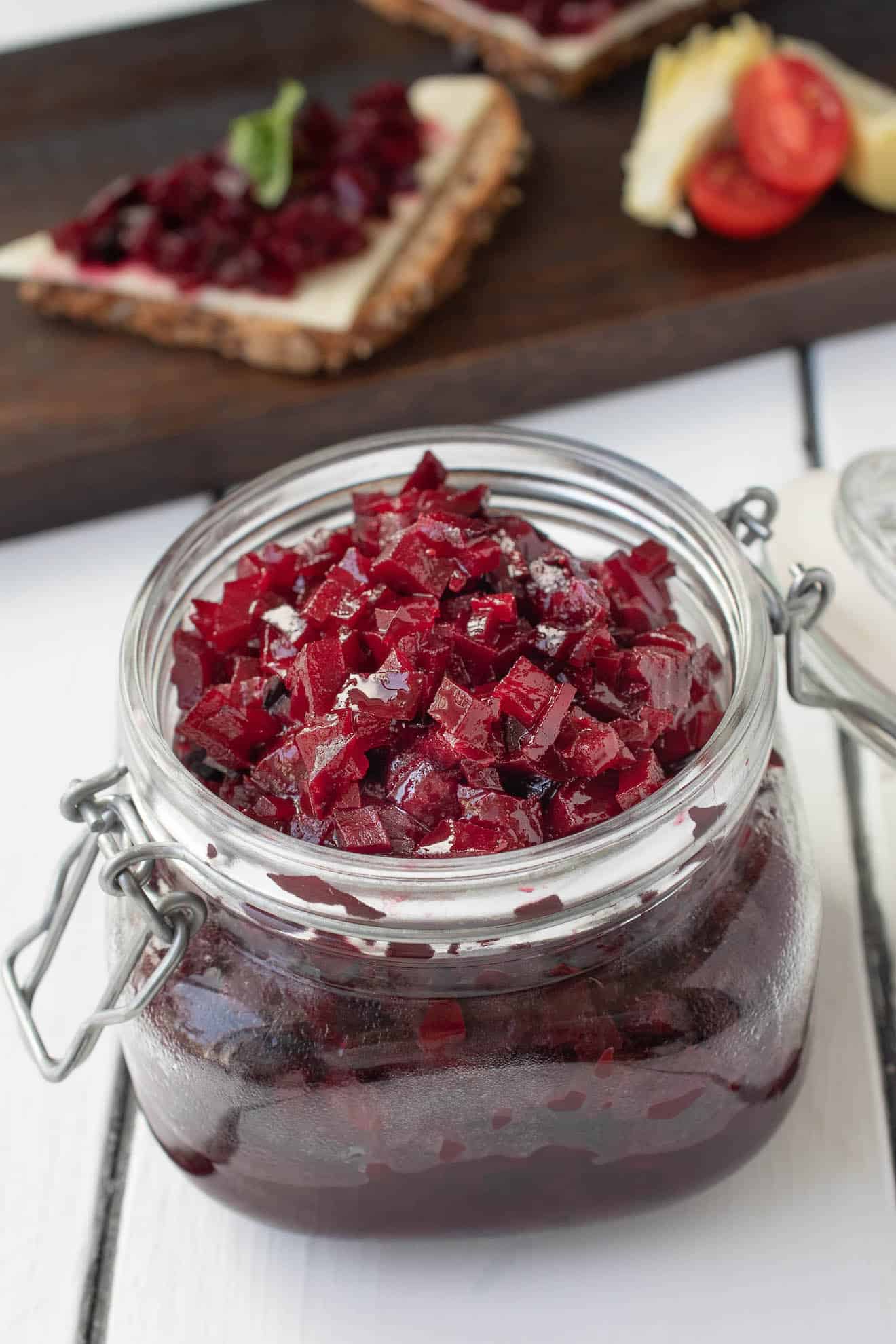
Beet Relish | Culinary Ginger
photo by Janette
From Culinary Ginger
This blog’s title Culinary Ginger refers to the color of the author’s hair. They’re a redhead, called a ginger in the UK. Beet or beetroot relish also has UK origins, and the recipe provides suggestions for serving it – I think I’d go for on a cheese sandwich. It’s a refrigerator pickle, but there are instructions for canning the relish for longer storage as well. This author suggests another method of roasting the beets: peel first and wrap them in foil before roasting.
.
.
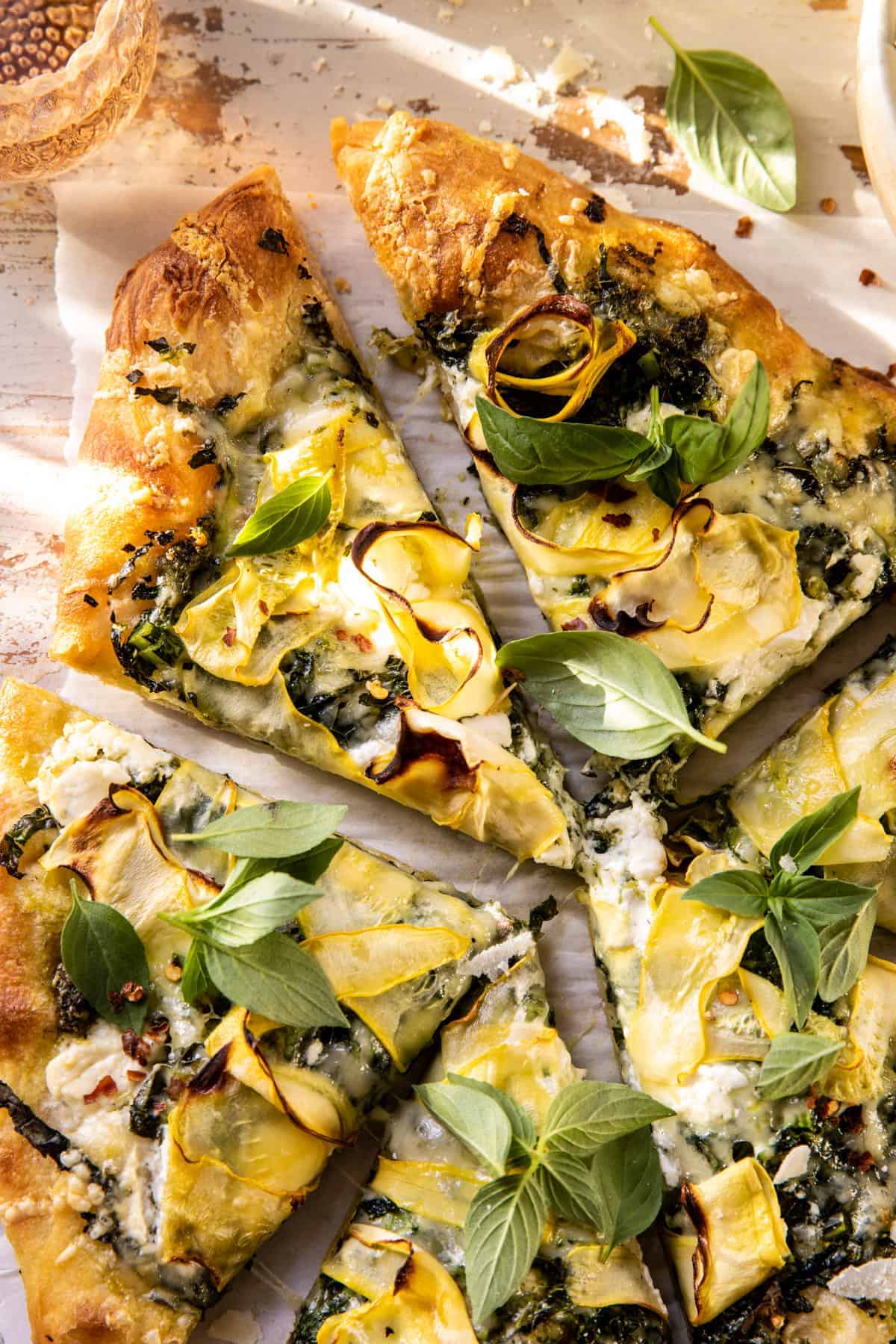
photo by Tieghan
Garden Greens Goddess Pizza | Half Baked Harvest
From Half Baked Harvest
You can use kale or collards as the greens in this no-tomato-sauce pizza from Half Baked Harvest. The pesto recipe uses pistachios, and you could easily sub any other type of nuts, and either increase the basil in place of the dill or mint, or use a few leaves of your greens. The recipe also suggest homemade or store bought pizza dough; here’s a link to 101 Cookbooks overnight yeasted pizza dough (with lenghty discussion!), and also a quick dough from Jamie Oliver. Jamie’s Cheat’s pizza dough calls for self-rising flour and here’s how to make that.
Week #8; Happy July 4th and Berry Wrap-up
- On: July 05, 2023
 0
0
Little Evansville puts on a great July 4 celebration. This year, it was a five day party. They’ve got the best parade in the area, fishing and arm wrestling tournaments, music in the beer tent every night, including the middle-school art teacher’s popular band. Lunker lob, ice cream social, euchre tournament, 5K and 10K runs, grilled brats and burgers from the FFA kids. Chicken BBQ, a pie sale, duck derby, baseball and a great fireworks show. Come check us out some year!
Berry Wrap-Up
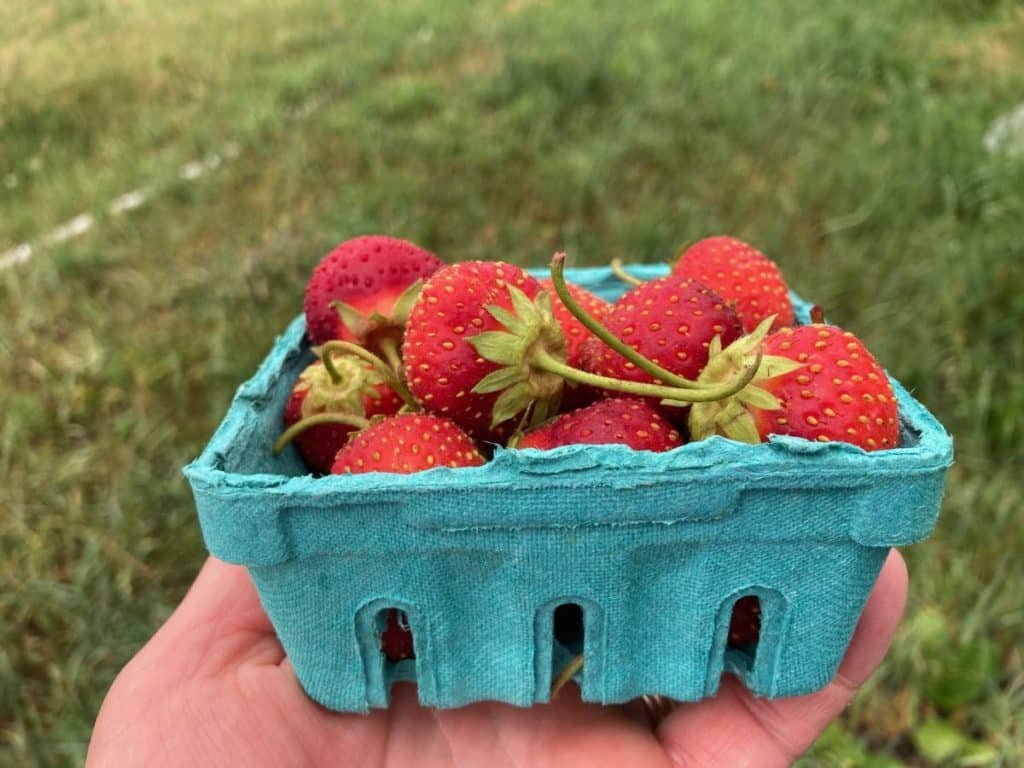
We’ve got cute 3/4 pint containers for you this week. The berries are ripe, ripe, ripe so eat them promptly. We are pretty excited to deliver berries for a fourth week. Three weeks is a typical season.

Even more unusual is the berry size. Most, years they are quite small by this point in the season. This year, they have stayed large, even this week. We lost early berries to an unexpected frost in late May but our main variety ‘Jewel’ seems able to compensate by plumping up the later ones.

Larger berries mean faster harvests. This is Katie, harvesting this week.

But here are Karen and Mary Ann harvesting last week on one of the worst air quality days. Many of you asked me how we handled the smoke. As you see, many of us wore N95s outside. That was not fun. We closed up the barn with air filters running, and rotated people between indoor and outdoor jobs. Finally, we just sent everyone home early on the worst days.
The second strawberry u-pick went smoothly; smaller and quieter than the first one. We hope that everyone who wanted to pick berries was able to get a reservation. We have to limit the picking reservations to how many berries have ripened. With luck, we will have abundant berries next year. We plan to have two fields ready to harvest in 2024 (instead of one field) so there should be berries for all. You might even be able to bring your friends.
Thanks for reading.
Beth
Veggie List & Veggie Notes
Week #8, July 6/7, 2023
– Weekly shares
– BiWeekly/ green
– Sampler/ D group
Strawberries, 3/4 pint
Broccoli, 1.5 – 2 lb
Snap peas, and
Snow peas, 3/4 lb total
(Both types of peas are in one bag.)
Swiss chard, 1 bunch
Cucumbers, 1 or 2
Zucchini &/or Zephyr squash, ~3 lb
Scallions, 1 bunch
Basil, 1 husky sprig
Next week’s box will probably contain broccoli, greens, cucumbers, zucchini, Walla Walla onions, basil and more.
Strawberries – These are the final berries of the season! Eat immediately or refrigerate.
Broccoli – The broccoli plants did great this spring despite the bewildering weather. It’s one of our nicest spring broccoli harvests in a few years.
Storage: Cover and refrigerate.
Snap and snow peas, together in one bag – As usual, both types are in one bag. We really like this new snap pea variety, SS141. How’s that for a romantic name? Long pods, sturdy plants and good flavor despite the heat. Hot weather is always a challenge for peas. Enjoy this batch. Both snap and snow peas have strings this week.
Storage: Refrigerate.
Swiss chard – Now that spinach is done for the year, it’s time to re-purpose your spinach recipes to Swiss chard. They are closely related. Chard has a thicker leaf and requires a few minutes more cooking to achieve tenderness, unlike spinach which wilts quickly.
Storage: Cover and refrigerate.
Scallions – These are the last scallions until fall. It’s been a good run. We will have sweet Walla Walla onions ready next week.
Basil (branched, leafy stalk) – Everyone gets a husky stalk, the first cutting of the season.
Storage: Basil deteriorates if stored in the refrigerator. It is best stored at room temperature with the cut ends in water, for example in a jar or vase. Treat it like a flower. Give the stem a fresh trim and change the water every day or two. You will receive a large branched stalk that I encourage you to cut down to the smaller individual stems. The smaller stems take up water better and stay fresh longer. See photo.
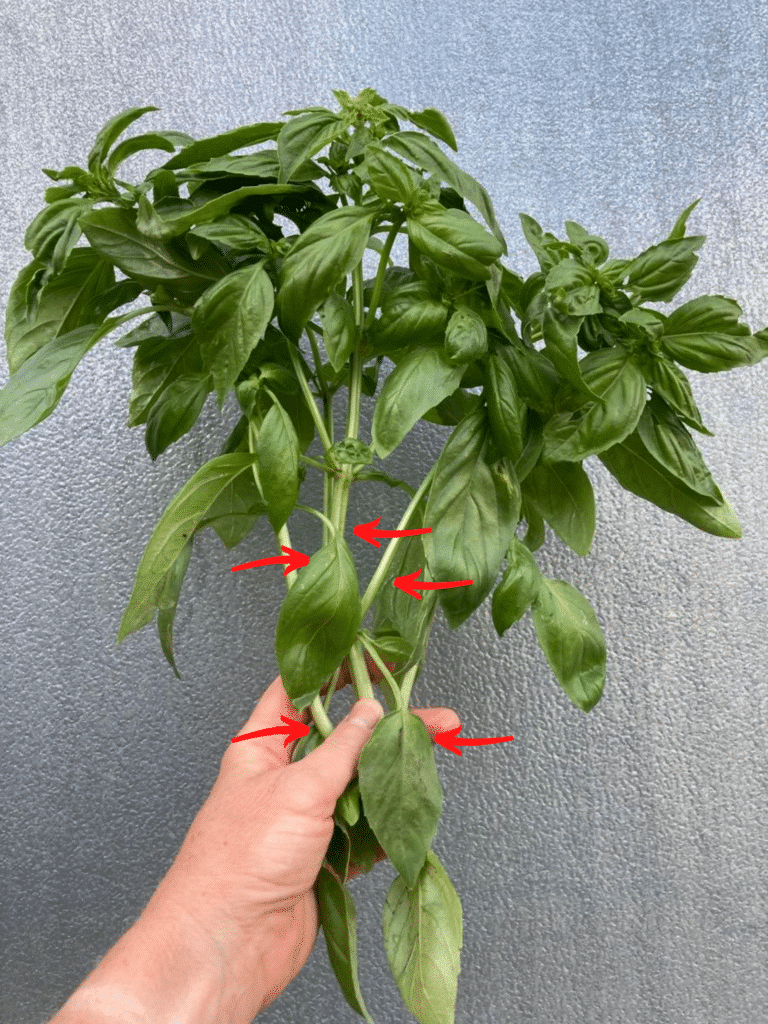
Large basil stalk. The arrows show where to cut into smaller stems.
RECIPES by DEB
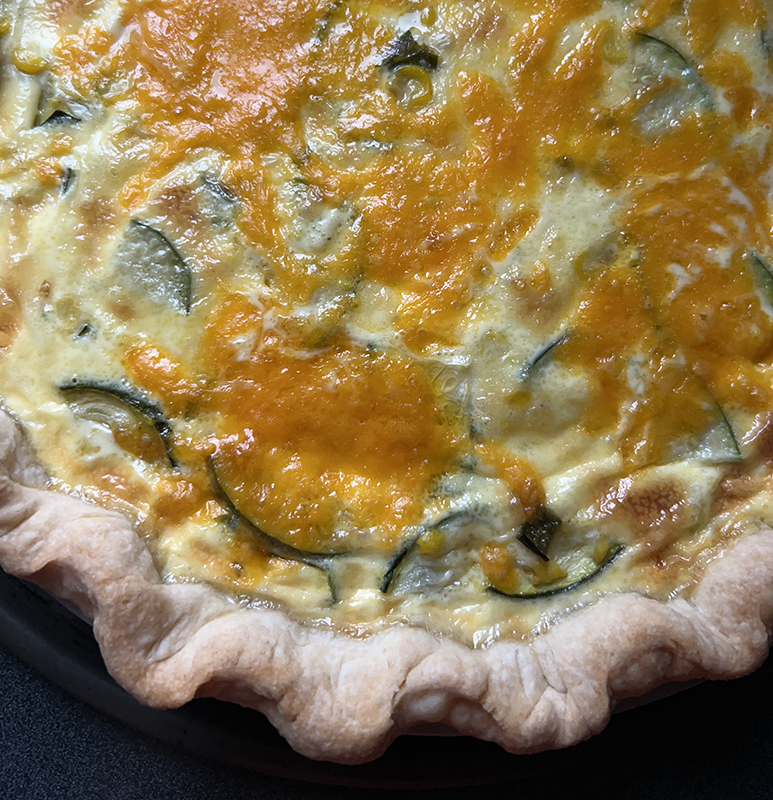
Photo by DebsLunch
Calabacitas Quiche
Calabacitas is a vegetable dish served in New Mexico and Texas and other parts of the US Southwest that usually consists of zucchini or summer squash, corn, onion, often cheese, and especially in New Mexico, roasted green chiles or poblanos. Calabacitas can also be used as a quesadilla filling – and in quiche! I’m including it this week because you can make it with zucchini and/or yellow squash, and frozen or canned corn and canned chiles until we get fresh corn and chiles in our boxes.
Serves: 6-8
Takes: about 40 mins. active time, plus an hour to chill the crust.
Crust ingredients:
1 1/2 cups flour
nice pinch of kosher salt
2 teaspoons sugar
6 tablespoons unsalted butter
3 tablespoons vegetable shortening
Filling ingredients:
2 tablespoons butter
One bunch of scallions, sliced, including white and green OR 3/4 cup chopped onion
1 large zucchini or 2 small, or a mix of zucchini and yellow squash, quartered longwise, and sliced
1 large or 2 small poblano chiles, roasted, skinned, seeded, and chopped OR one 4 oz. can mild green chlies
3/4 – 1 cup corn kernels, fresh cut from 1-2 ears, frozen, canned, or whatever you’ve got
salt & fresh ground black pepper to taste
1 cup grated cheddar cheese
3 eggs
1 1/2 cups half & half
- Make the crust: Measure the flour into a bowl and add the sugar and salt. Cut the shortening and butter into cubes over the salt and flour. Cut the fats into the flour with your fingers, a pastry blender, or paddle attachment of your stand mixer, until the mixture resembles coarse meal. Drizzle in about 1/3 cup cold water, while stirring, until you’ve got a bunch of small clumps of dough. Dump out onto a floured surface, knead lightly to bring it together, and then flatten the dough into a disk and wrap in wax paper or plastic wrap and chill for about an hour.
- Make the filling: melt the butter in a large skillet, and add the scallions or onion. Sauté over medium heat until the onion looks translucent, then add the zucchini. Cook until the zucchini is starting to soften, and then add the poblanos or chiles, corn, and salt & pepper. Cook until the squash is just tender, and then set aside to cool.
- Assemble the quiche: Heat the oven to 375° with a rack near the bottom and another near the middle of your oven. Roll out the crust and fit it into a 9-10 inch pie dish. Put 2/3 of a cup of the grated cheese in the bottom, then add the zucchini filling. You’ll find some images of rolling out crust and fitting it into a pie dish here.
- Beat the eggs, add the half & half, and pour this custard into the crust.
- Place the quiche on the bottom rack and bake for 10 minutes. Sprinkle the remaining 1/3 cup of cheese over the top of the quiche, and bake for another 10 minutes. Move the quiche up to the middle rack and continue baking until it is puffed and golden brown in spots, about 20 minutes more. Cool for 15 minutes before serving either hot or warm.
Spaghetti with Swiss Chard and Garlic Chips | smitten kitchen
From smitten kitchen
Deb Perelman adapted this recipe for Swiss chard pasta from the dearly departed Gourmet magazine; the orginal included currents that she omitted, so feel free to omit them yourself. The combination of chard and garlic chips is maybe a bit autumnal, but you can make it more summer-y by subbing in our scallions for the onion, and a garnish of sliced basil leaves wouldn’t be amiss here.
.
.
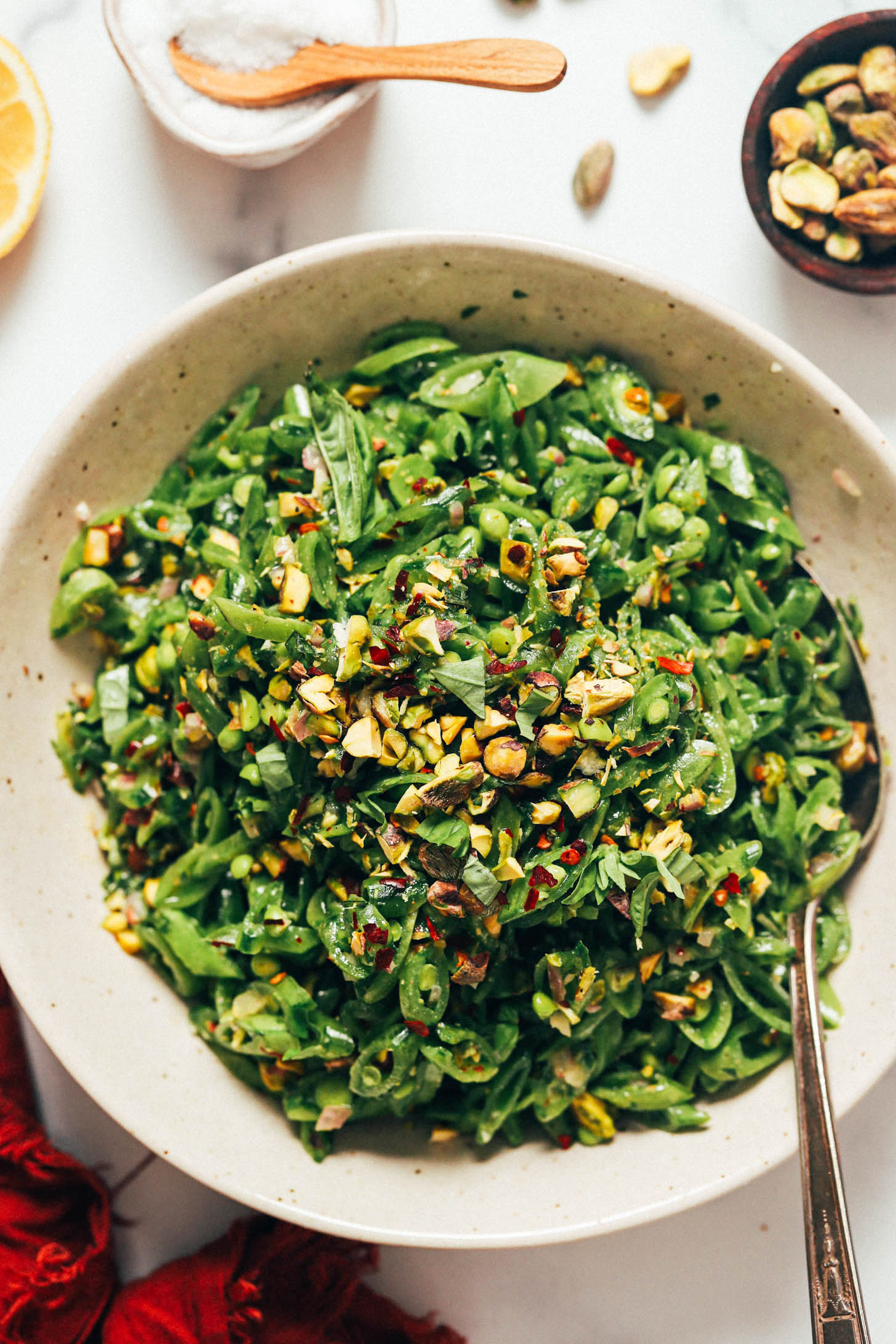
Snap Pea Salad with Zesty Lemon Vinaigrette | Minimalist Baker
From Minimalist Baker
This quick pea salad from Minimalist Baker can be made with the combo of snow and snap peas in this week’s box – all you need to do is rinse and string both types of peas and cut them all on the diagonal, about the same size. The recipe called for four cups of sliced peas for 4 generous servings of salad, and the 3/4 pound of peas in the box will not yield that much sliced up. I suggest either adding chopped broccoli to get to four cups, or you could also halve the recipe.
.
.
Caesar Roasted Broccoli | The Kitchn
From The Kitchn
This version of roasted broccoli is somewhere between a salad and a side dish, but is right on delicious. As the recipe points out, if you are nervous about using raw egg yolk to make a classic Caesar dressing, you can sub a tablespoon of mayonnaise. Beth also provided a link to a method for pasteurizing eggs in the microwave in last week’s newsletter. And personally, I do not care for anchovies, and I sub a few shakes of Worcestershire sauce, a teaspoon or so, in place of the anchovies.
.
.
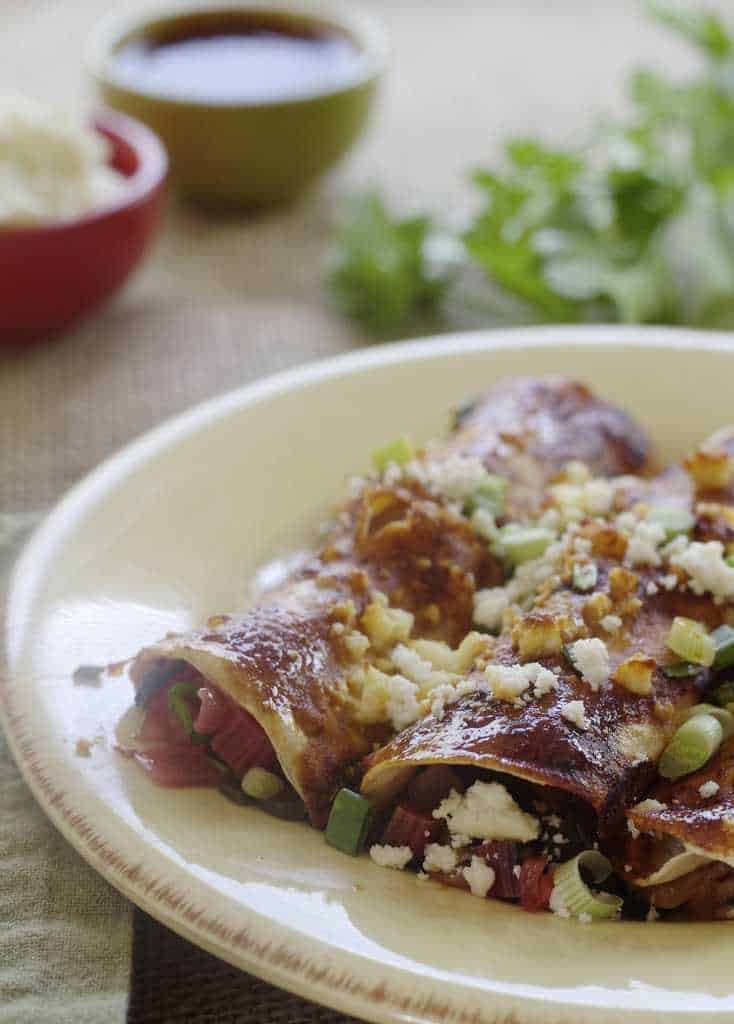
Vegetarian Chard Enchiladas | Letty’s Kitchen
From Letty’s Kitchen
Create this vegetarian main course with the chard and scallions in this week’s box. You can use purchased or homemade enchilada sauce and Letty’s Kitchen provides links to both a recipe that uses soaked and pureed whole dried chiles, and a quick version with chili powder, although I’d suggest using ground red Ancho chile in the quick sauce – you can find it at Penzey’s and Willy Street Co-op.
.
.
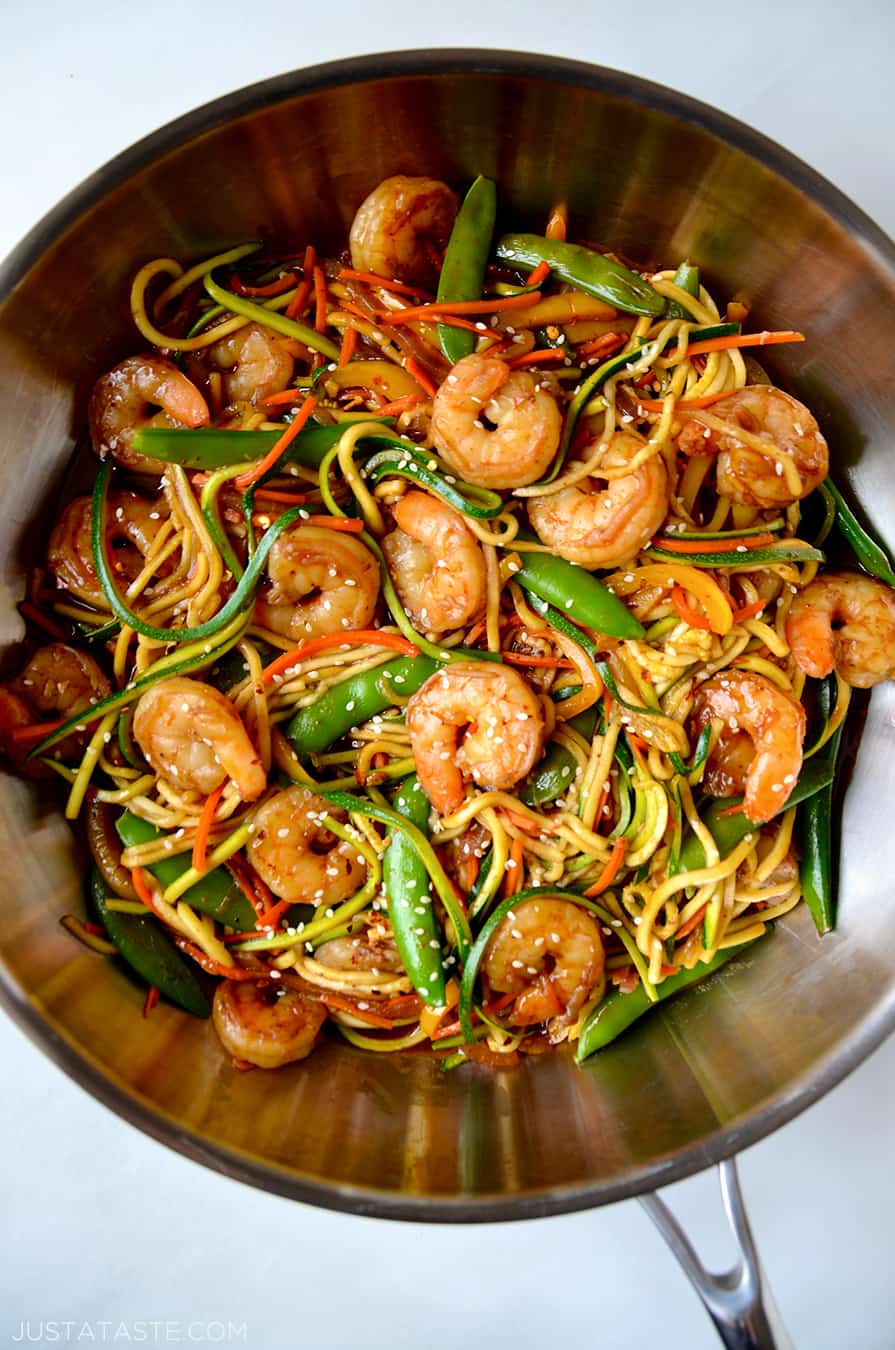
Photo by Kelly Senyei
Zucchini Noodle Stir-Fry with Shrimp | Just a Taste
From Just a Taste
Probably the best part of this recipe is that it gives you several methods for creating the zucchini noodles, zoodles, even if do not own a spiralizer or mandoline. It also provides an easy stir fry sauce made with common pantry ingredients like soy sauce and cornstarch. You can sub in sliced chard leaves and stems and broccoli for the carrots and bell pepper.
.
.
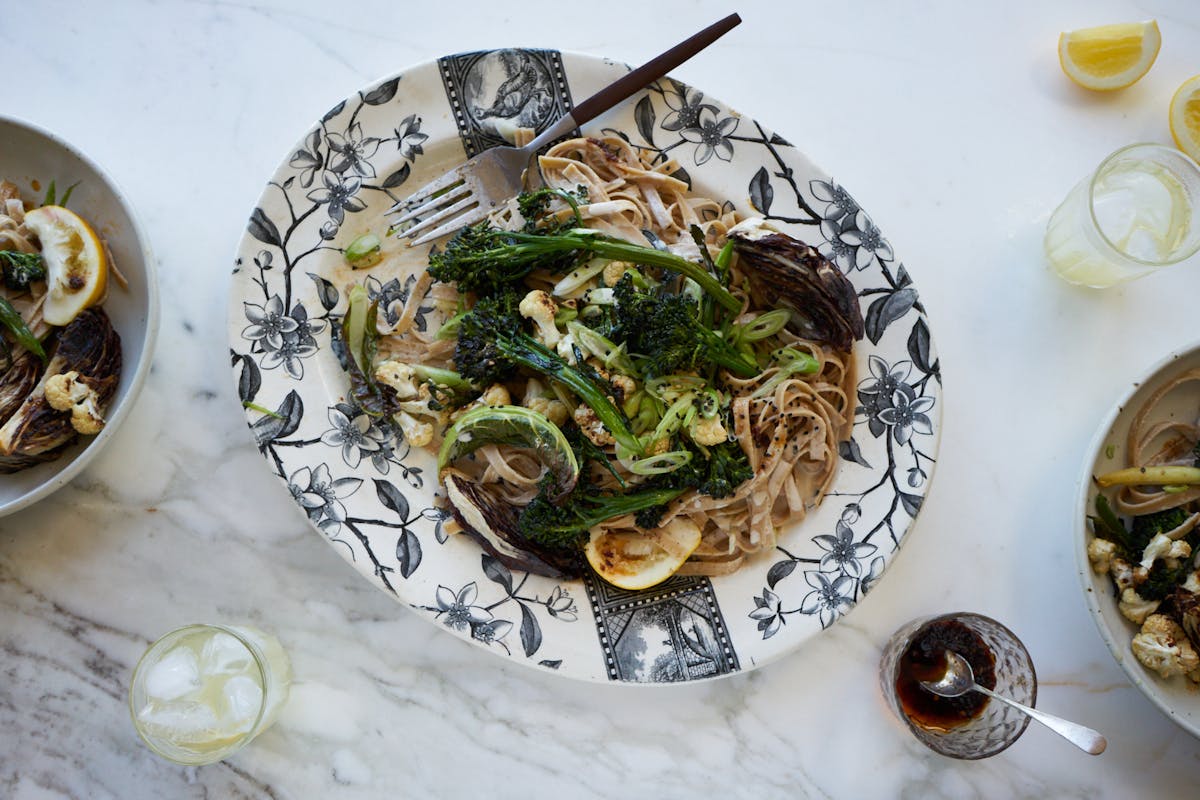 Photo by Heidi Swanson
Photo by Heidi Swanson
Spicy Tahini Noodles with Roasted Vegetables | 101 Cookbooks
From 101 Cookbooks
This recipe is really a formula for sesame noodles with roasted vegetables. The author, Heidi Swanson, invites you to raid your vegetable crisper to come up with about a pound of roast-able vegetables, and that means you can use a combination of the broccoli, zucchini, and summer squash from this week’s box, and you can also throw in a handful or two of the snap and snow peas. And if you don’t happen to have tahini, you could use peanut butter or almond butter in the sauce, although they’d be peanut or almond noddles in that case.

